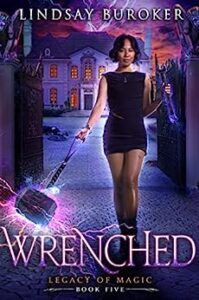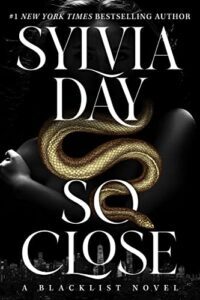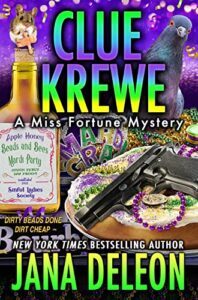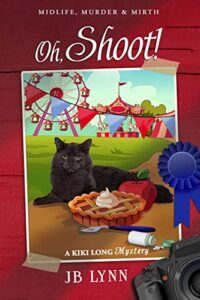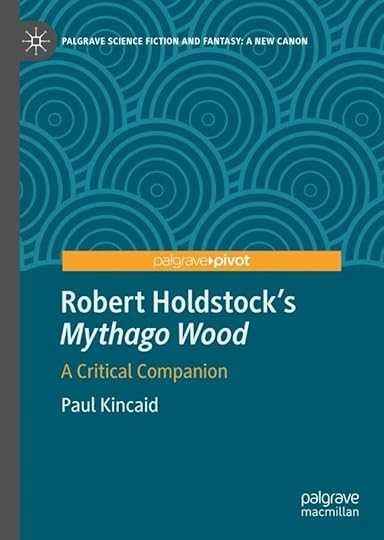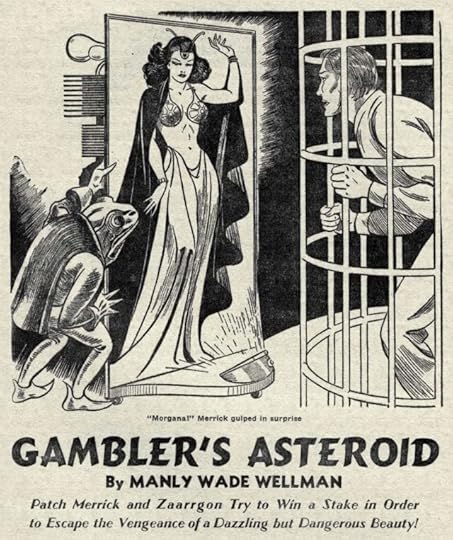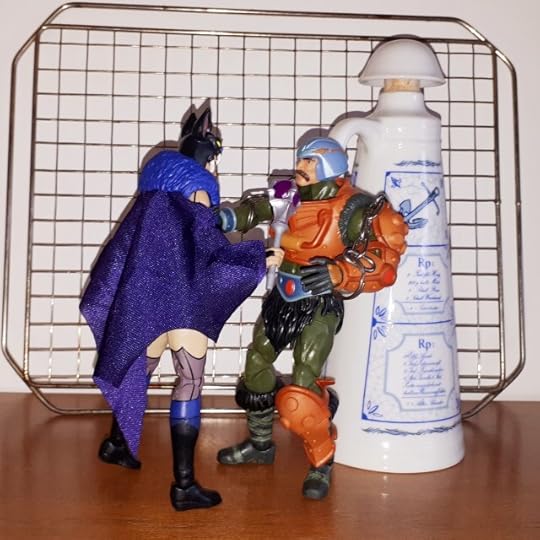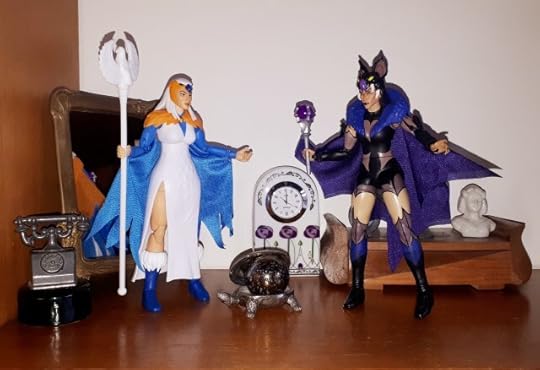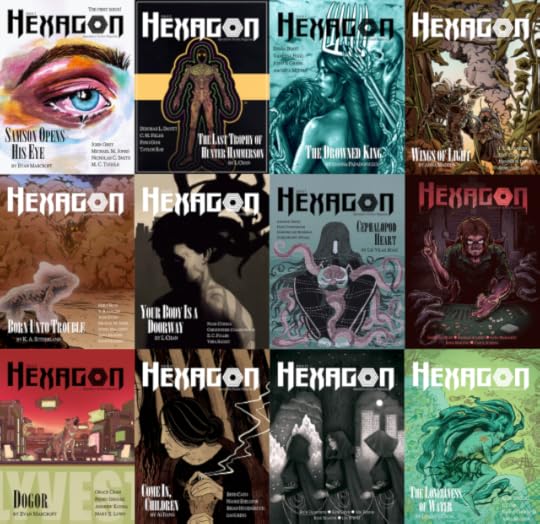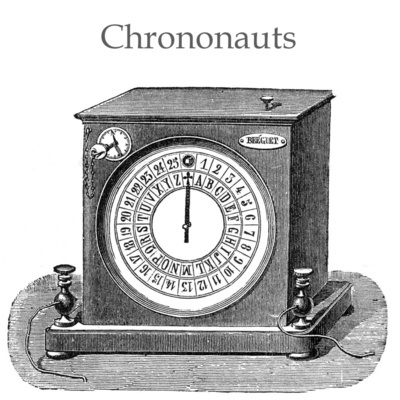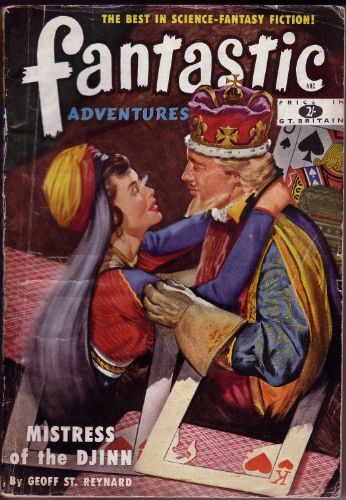Cora Buhlert's Blog, page 14
March 30, 2023
The Mandalorian and Baby Grogu delve into the backstory of “The Foundling”
Welcome to the latest instalment of my episode by episode reviews of season of The Mandalorian. Previous installments may be found here.
Warning! Spoilers behind the cut!
After last week’s detour into 1970s style dystopian science fiction and the fate of Doctor Pershing, The Mandalorian returns to its main protagonists, everybody’s favourite Clan of Two. As the title indicates, this episode focusses on everybody’s favourite fifty-year-old Force-wielding toddler Grogu.
After spending most of the previous episode on Coruscant, we’re back on the unnamed planet that looks suspiciously like the South-Western US, where the Armourer and her flock have holed up – quite literally, since they live in a cave. We also get a glimpse at what Mandalorians do during their downtime, namely practice fighting and engage in friendly, but competitive contests on the edge of the very lake that belched up a giant Mandalorian-eating monster in the first episode of the season. Bo-Katan is wandering around among the group and seems impressed by what the Armourer has built up.
Meanwhile, Grogu is sitting on the beach and amuses himself by arranging stones in a circular pattern, only that the stones stubbornly move, because they are a type of hermit crab. Speaking as someone who as a kid picked up a promising looking seashall more than once, only to find it inhabited by a hermit crab, I certainly sympathise with Grogu. Grogu’s contemplation is interrupted by his Dad, who picks him up and tells him it’s time he started his training.
A bunch of Mandalorian kids are engaging in friendly matches under the watchful eye of a referee. Ragnar, the kid we saw take the creed in the first episode and also the son of Paz Vizla, the portly Mandalorian who seems to be the Armourer’s right-hand man, has just beaten his opponent, when Din shows up with Grogu in tow and challenges Ragnar on behalf of Grogu. Ragnar is initially sceptical – Grogu is a toddler after all and doesn’t even have a helmet, whereupon Din solemnly declares that Grogu doesn’t have a helmet, because he is too young to speak the creed. But he can fight all right. Ragnar finally relents, expecting an easy victory, especially since Grogu doesn’t even seem to understand what is expected of him.
The weapon chosen are darts, basically little exploding paint balls fired from a wrist gauntlet. The gauntlet is so big that it barely fits on Grogu’s arm. Din tries to explain to Grogu how the darts work, while Bo-Katan tells Grogu, “It’s okay. My Dad was the same. It just means he’s proud of you.” In fact, the whole scene, complete with anxious hovering dads egging on their kids, reminds me of youth sports – whether it’s football, baseball, tennis, figure-skating or something else – and the interplay between kids and parents in the real world. In fact, the idea of heavily armed football/baseball/tennis/figure skating parents is both hilarious and terrifying.
You need to score three hits to win. Ragnar easily scores two, largely because Grogu either doesn’t quite understand the game or is simply not interested in playing. During a break, where the Dads coach their kids, Din says to Grogu that he knows what Grogu can do and that he shouldn’t hold back. So when the match restarts, Grogu Force-flips over Ragnar’s head, fire all three darts and hits Ragnar point-blank in the chest. Din is a very, very proud Dad and even the Armourer is impressed by Grogu’s abilities. Unlike Bo-Katan, she hasn’t really interacted with Jedi and other people with Force abilities before, so Grogu’s Force abilities are a surprise to her.
While everybody is congratulating Din and Grogu, Ragnar slinks off to sulk, which is understandable, considering he has just been beaten by toddler. But then, all of a sudden, a giant pterodactyl-like creature – Tor.com‘s Emmet Asher-Perrin and io9 Germain Lussier refer to it as a “raptor” – swoops out of the sky and grabs Ragnar. Much as I enjoy the fact that every single ecological niche in the Star Wars universe is inevitably populated by a giant monster, I do find it a bit troubling that the Armourer and her flock have decided to settle on a planet full of mega-fauna that wants to eat them and don’t even take the slightest precautions to protect themselves.
The raptor flies off with Ragnar and several Mandalorians, including Din and Ragnar’s Dad Paz Vizla, give chase. However, their jetpacks run out of fuel well before they can track the raptor to its nest. Luckily, Bo-Katan had a better idea and follows the raptor in her ship. She then returns with the location of the raptor’s nest on top of a mountain in a difficult to access area.
A rescue plan is made. The Mandalorians haven’t figured out how to repell the raptors or at least warn them of their attacks, but they do know that if the raptor hears the sounds of jetpacks, it will kill Ragnar, because apparently, it has snagged other kids before. Therefore, Bo-Katan suggests landing the ship out of sight and covering the rest of the way on foot and then climbing to the nest to rescue Ragnar. Since Bo-Katan knows the location of the nest and came up with the plan, she will lead to rescue party. Din is along for the ride, of course, as is Paz Vizla – it is his kid, after all. Grogu would love to go along as well, because he doesn’t like being separated from Daddy, but Din and Bo-Katan tell him that he is too young and it’s too dangerous.
The rescue party makes it to the mountain, where the raptor has its nest, and decide to spend the night under an overhanging rock out of the raptor’s line of sight. A camp fire is lit – I guess the raptor doesn’t have a very highly developed sense of smell – and food is distributed. “How do you eat without taking off your helmets?” Bo-Katan whispers to Din, who replies that everybody goes off to find a private place to eat. Bo-Katan is about to do just that, when Paz Vizla shows up and announces that as the leader of the war party, Bo-Katan will be granted the honour of staying by the fire. Once everybody is gone, Bo-Katan takes off her helmet to eat, looking rather frustrated at the idiotic customs of Din’s people. Regardless of what you think of the requirement to never take off your helmet in public, the party splitting up and everybody going off on their own is also a needless risk to take on a planet teeming with hostile, Mandalorian-eating mega-fauna and makes it really easy to pick off the Mandalorians one by one.
Alas, this does not happen and after a good night’s rest, the party climb the mountain, using ropes as well as their hands and feet. They reach the nest and it’s huge. The nest is seemingly empty, but Din scans it and detects a heat signature. Against all warnings, Paz Vizla rushes in to save Ragnar. However, the heat signature doesn’t belong to Ragnar. Instead, it’s three baby raptors and they’re hungry and noisy. Worse, Mama raptor shows up, regurgitates young Ragnar from her crop, since he was intended as a meal for her babies. However, Mama Raptor first needs to deal with those pesky Mandalorians who have interrupted feeding time.
Hands up, who did not expect the nest to be full of baby raptors and the very angry Mama raptor to show up? Cause it’s a really obvious development to anybody who’s ever observed nesting birds or watched any cartoon involving giant monster nests. However, Mandalorians clearly aren’t bird watchers and the Star Wars universe apparently doesn’t have cartoons involving giant monsters. And so no one expected Mama raptors and her babies.
However, the Mandalorians quickly regroup and attack Mama raptor with all they have. They try to capture and tie her down with ropes and pry Ragnar out of her claws. In the end, Din saves Ragnar, earning him the undying gratitude of Paz Vizla. As for Mama raptor, she falls into a lake and is promptly gobbled up by one of those turtle aligator creatures that attacked the Armourer’s congregation in the first episode, once again proving that the truest line ever said in any Star Wars movie was Qui Gon Jin’s remark in The Phantom Menace that “there is always a bigger fish”.
While all this is happening, the Armourer has taken on Grogu babysitting duties. She takes him to her forge, explains that the forge is the heart of Mandalorian culture and that this is where Mandalorians are tested to reveal weaknesses and then forged into something stronger. The Armourer gets to work and her rhythmic hammering causes Grogu to experience a flashback to his rescue from the Jedi Temple during the night of Order 66. Interestingly, Din experienced something similar in season 1, when the Armourer’s hammering caused him to flash back to the attack on his homeworld that killed his parents, until he was rescued by the Mandalorians. So is there something hypnotic about the Armourer’s forge that causes people to relive traumatic memories?
At any rate, we’re back at the Jedi Temple during Order 66. Stormtroopers are attacking and killing everybody, while four Jedi are doing their damndest to get Grogu in his floating crib to safety. However, the Stormtroopers cut them down one by one. The last Jedi, a human woman, managed to push Grogu’s crib into an elevator. The elevator rises and when the doors open, a Jedi Master named Kelleran Beq awaits Grogu and he is played by none other than Ahmed Best, the actor who played Jar Jar Binks in the prequel trilogy.
Now Star Wars fandom has been beset by toxic elements since the beginning and backlashes against anything that taints the purity of the universe in the eyes of these toxic fans is mercilessly critcised and shredded. We saw this phenomenon as early as Return of the Jedi, where toxic fans hated the Ewoks for being too cutesy and cuddly (and I guess some folks found things to hate about The Empire Strikes Back as well). However, by the time the prequels came out, the internet was in the process of mass adoption, so the toxic fans were a lot noisier and their targets were not just the characters and bad writing, but also the actors who brought those characters to life. And since Jar Jar was widely hated by Star Wars fandom (though a lot of casual viewers liked him), Ahmed Best and Jake Lloyd, who played young Anakin, got the brunt of it.
Both Ahmed Best and Jake Lloyd experienced depression and even suicidal thoughts as a result of this backlash, even though they were not responsible for the issues with their characters or the script. Personally, I never understood why people had problems with Jake Lloyd’s performance, since I’d seen him in a recurring role in The Pretender well before he was Anakin and knew he could act. Never mind that he was only ten at the time. I hadn’t knowingly seen Ahmed Best in anything before The Phantom Menace (though it turns out he was in the touring production of Stomp, so I may well have seen him in that), but while Jar Jar is a hard character to like, the actor really isn’t to blame for that.
StarWars.com has an interview with Ahmed Best in which he opens up about how difficult returning the Star Wars was for him after his experiences during the prequels. What made things even worse was that Ahmed Best was a life-long Star Wars – he’s my age, so he would have been – only that his dream of being in Star Wars turned into a nightmare.
When “The Foundling” aired, Ahmed Best suddenly trended on Twitter and my first thought was, “Oh crap, is he dead?” But it turned that no, he was actually in The Mandalorian, he played a Jedi and he was awesome. And in fact, everybody seems to be happy that Ahmed Best got some vindication for the terrible way Star Wars fandom treated him 24 years ago. Though could we maybe stop abusing Star Wars actors, because we don’t like the characters they play? Because it’s not as if Star Wars fandom has learned from what happened to Ahmed Best and Jake Lloyd. After all, John Boyega, Kelly Marie Tran and Moses Ingram were also subjected to abuse for their roles in the sequel trilogy and Obi-Wan Kenobi. It’s also notable that except for Jake Lloyd, all of the actors who suffered abuse at the hand of Star Wars fandom are actors of colour.
Kelleran Beq, who is awesome by the way, demolishes a squad of Stormtroopers with two lightsabres and then loads Grogu into the sidecar of his speeder bike for a high-speed chase through the skies of Coruscant. AV-Club reviewer Sam Barsanti complains that the Coruscant chase is too reminiscent of last week’s episode, down to the fact that we see the commuter air train that played such an important role in “The Convert” as well as the rock that is the top of Coruscant’s highest mountain. He’s not wrong, because the locations are the same except for the Jedi Temple, which wasn’t seen in “The Convert”. However, creating the Coruscant backgrounds was likely time-consuming and expensive, so I cannot fault the showrunners for wanting to reuse them. And besides, that mountain top is cool.
Kelleran Beq takes Grogu to a blood-red Naboo starship docked on a landing platform. “Where are the others?” the crew asks, suggesting that Kelleran Beq was supposed to rescue more people than just Grogu. “There are no others”, Kelleran replies. He, Grogu and the crew board and the starship takes off, while Stormtroopers fire after it.
This flashback answers one pressing question about Grogu, namely how in the universe did he manage to escape from the massacre at the Jedi Temple and from Coruscant, considering he was just a baby – and it’s notable that Grogu looks younger and more babyish in the flashback scenes than in the present day.
However, there are still a lot of questions left unanswered, namely how exactly did Grogu end up in the heavily fortified component where Din found him? What happened to Kelleran Beq, who clearly was supposed to protect Grogu and yet is nowhere to be seen, when Din and IG-11 storm the compound? And who exactly is Grogu and why is he deemed so much more important than the other padawans at the Jedi Temple? Is it because his species is particularly Force-sensitive – after all, the only three member’s of Grogu’s species we’ve ever seen were all Jedi? Or is Grogu the secret love child of Yoda and/or Yaddle? After all, Yoda very much knows where the little padawans come from and does his damndest to bring Anakin and Padmé together to make little Jedi. And much as I love Yoda, he has always been rather flexible in his interpretation of the Jedi code, so I don’t find it at all hard to believe that he has a secret lover somewhere.
But whatever Grogu was originally, now he is a Mandalorian foundling and the Armourer finally reveals what she has been working on – namely a circular chest plate with the signet of the mudhorn, symbol of his and Din’s Clan of Two. “This will protect you,” the Armourer tells Grogu. Din will be a very proud papa indeed, once he sees the new armour upgrade.
When the rescue party returns with Ragnar, the assembled Mandalorians cheer and rejoice. The Armourer praises Bo-Katan, because she has fulfilled the highest purpose, namely to safe a foundling. However, Bo-Katan hasn’t just helped to save Ragnar – no, the Mandalorians also brought back the three raptor babies, because now that their mother is dead, they are foundlings, too. I have to admit that I was surprised by this, because while the Mandalorians’ commitment to rescuing and saving lost children extends beyond humans – after all, Grogu is very much not human – I didn’t expect it to extend to non-intelligent creatures like the raptors. On the other hand, do I see “Raptor Riders of Mandalore” on the horizon there? Cause that would be awesome.
Indeed, the thing I like most about The Mandalorian is that it turned the Mandalorians from a group who are mainly warriors to a people who are primarily define themselves as parents who protect and train the many orphaned children created by the constant warfare in the Star Wars universe. This episode very much reinforces this, because it focusses almost entirely on how much Mandalorians care for their children, both biological (Bo-Katan appears to be the biological daughter of her unseen father) and adopted.
Bo-Katan has lost a shoulder pauldron in the fight with the Mama raptor, so she asks the Armourer for a replacement. The Armourer takes her to the forge and asks Bo-Katan, if she wants the signet of the night owl, a symbol of her clan, on the replacement pauldron. Bo-Katan, however, asks if it would be okay if she wore the signet of the mythosaur, which is the symbol used by the Armourer’s group, instead. The Armourer agrees, because the mythosaur is a symbol for all Mandalorians.
While the Armourer works, Bo-Katan tells her that she saw a mythosaur. “A noble vision”, the Armourer replies. Bo-Katan insists that no, she really saw a mythosaur in the living waters underneath Mandalore. The Armourer, however, doesn’t seem to be convinced. “You will see many thing, when you walk the way of the Mandalore”, she declares.
Pretty much everybody seems to agree that this episode is a lot of fun, but doesn’t exactly progress the overall plot, if there even is one. And indeed, it doesn’t. However, The Mandalorian has always been a meandering show that moved at its own pace and particularly the early episodes of every season so far were full of detours and side quests. It’s usually not before the half or two-third point of every season that the pace picks up and the various threads and side quests come together to form a coherent whole. I strongly suspect that season 3 won’t be any different.
Episodes of The Mandalorian and The Book of Boba-Fett tend to draw a lot on the original inspirations for Star Wars as well as on other movies and media that were popular around or just before the time Star Wars came out. And so we have Italian westerns, Kurosawa films, biker films, depressing 1970s dystopian science fiction films and others, all reinterpreted through a Star Wars lens. This episode with its giant monster mama and her babies, the focus on children in need of rescue and the message that monsters (well, monster babies) have a right to live as well is very remiscent of the Saturday morning cartoons of the 1980s. Honestly, replace Din, Paz Vizla and Bo-Katan with He-Man, Man-at-Arms and Teela, replace the Armourer with the Sorceress, don’t kill of the raptor mama and add a neat little moral message at the end and this could be a 1980s Filmation He-Man episode. Again, this is very appropriate, because the Saturday morning cartoons of the 1980s were all strongly influenced by the original Star Wars trilogy as well as drawing on the same pulp SFF influences as Star Wars.
One thing that surprised me is what a big role Bo-Katan plays in season 3. Based on the trailers, I expected her to be an antagonist, maybe even the main antagonist, considering that Din has the one thing she really needs, the darksabre. However, their relationship is not really antagonistic at all. I also expected Bo-Katan to try to take over the Armourer’s group – after all, she needs followers. But again, she doesn’t seem to be doing any of that. If anything, the Armourer gradually seems to be persuading Bo-Katan of the rightness of “the way”.
Kristin Baver’s interview with actress Katee Sackhoff, who plays Bo-Katan, at StarWars.com also reveals that Katee Sackhoff herself was surprised by how big a role her character plays in season 3. In fact, I wonder whether Bo-Katan’s role grew bigger, when the showrunners were forced to write out Cara Dune, who up to then had been the most important female character in the show.
So where is all this going and how will the different plot threads we’ve seen so far connect? I have no idea, though I suspect that we will find out soon, since we’ve reached the halfway point of the season.
Indie Speculative Fiction of the Month for March 2023

It’s that time of the month again, time for “Indie Speculative Fiction of the Month”.
So what is “Indie Speculative Fiction of the Month”? It’s a round-up of speculative fiction by indie and small press authors newly published this month, though some February books I missed the last time around snuck in as well. The books are arranged in alphabetical order by author. So far, most links only go to Amazon.com, though I may add other retailers for future editions.
Once again, we have new releases covering the whole broad spectrum of speculative fiction. This month, we have urban fantasy, epic fantasy, historical fantasy, cozy fantasy, sword and sorcery, paranormal mystery, science fantasy, space opera, military science fiction, Cyberpunk, horror, dragons, vampires, mages, shark shifters, elf assassins, exiled soldiers, genetically engineered space marines, alien invasions, crime-busting witches, crime-busting psychics, rival potion shops, roadside inns, terrors from the deep and much more.
Don’t forget that Indie Speculative Fiction of the Month is also crossposted to the Speculative Fiction Showcase, a group blog run by Jessica Rydill and myself, which features new release spotlights, guest posts, interviews and link round-ups regarding all things speculative fiction several times per week.
As always, I know the authors at least vaguely, but I haven’t read all of the books, so Caveat emptor.
And now on to the books without further ado:
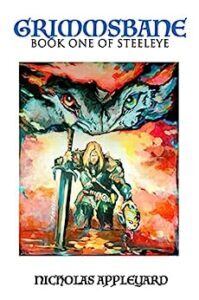 Grimsbane by Nicholas Appleyard:
Grimsbane by Nicholas Appleyard:
In times past, the Grimm Horde—a cursed people corrupted and commanded the dread sorcerer Aihaab—were defeated and banished to the underground kingdom of Ash Ul M’on. Their master, Aihaab, was slain, and the world breathed a sigh of relief.
But now fell auguries whisper that the darkness has returned. Crows circle the skies. Men quarrel and worship the shadows. And a changeling warrior, Steeleye, adopted by the noble clans of the North, dreams of a vast field of destruction and death in which a beautiful red-headed woman calls to him.
Though Aihaab was defeated, his seven dark servants—great demons of old—were not. Called by the Goddess of Death, The Morriggu, Steeleye must now embark upon a quest to rid the world of these ancient terrors before their new master, a force far more terrifying than Aihaab, completes the work Aihaab left undone…
Grimmsbane is the startling first book in the intended Steeleye series, an epic sword and sorcery tale in the tradition of Robert E. Howard. Combining heroic fantasy with cosmic horror, Grimmsbane explores the psychological price of heroism, the meaning of fellowship, and what it means to face one’s death with courage.
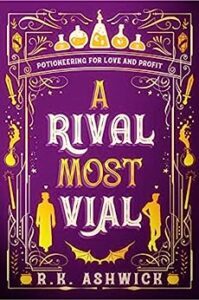 A Rival Most Vial by R.K. Ashwick:
A Rival Most Vial by R.K. Ashwick:
Two potion shops, one heated rivalry…until hate bubbles over into something else.
Any adventurer worth their sword knows about Ambrose Beake. The proud, quiet half-elf sells the best, and only, potions in the city—until a handsome new shopkeeper named Eli opens another potion shop across the street, throwing Ambrose’s peace and ledgers far off balance.
Within weeks, they’re locked in a war of price tags and products—Ambrose’s expertise against Eli’s effortless charm. Toil leads to trouble, the safety gloves come off, and right as their rivalry reaches a boiling point…
The mayor commissions them to brew a potion together.
The task is as complex as it is lucrative, pushing both men to the limits of their abilities and patience. Yet as the fires burn and cauldrons bubble…they find a different sort of chemistry brewing.
In the aftermath of a deadly invasion, Samaran is a land in turmoil.
Bandits prey on cities and farmsteads, corsairs prowl the high seas.
Ariel has earned her place with the elite Mage-warriors of the Eldrin, sworn to protect King and country––but power comes with a cost. The Elementals who can bestow dragonfire and ice-skills are wild and unpredictable, focused on their own long-term goals.
But now the sinister power behind the war is once more taking shape and form, the strength and skill of the Eldrin will be needed to lead the resistance.
For Ariel, life has become complicated. Visions of the distant threat haunt her dreams, her sister treads a precarious path as royal concubine and bodyguard, her Elemental ally seems to have gone rogue––and the love of her life has ended their relationship.
If only she can control the wild power inside her to defeat the raiders…
Then maybe she can protect her sister from the schemes of influential conspirators––and maybe even persuade Marin they can be reunited when the fighting is over…
Elf, dragon, wolf, and a mysterious Mage-warrior weave a dangerous path in this fantasy adventure-romance epic from Jay Aspen.
 The Inn of the Seven Stars by Kevin Beckett:
The Inn of the Seven Stars by Kevin Beckett:
A tale of an inn with good music, tasty food, strong beer … and inadvertent necromancy.
Travel is hard work and, for the Fiddler named Cal, any stop at an inn is a place to perform, to share the songs and music he has loved and, perhaps more importantly, use those in exchange for a warm bed, good food, free drinks, and maybe some extra coin.
However, the roads we travel are roads that have existed long before we set foot on them and, at the crossroads where Cal finds the Inn of the Seven Stars, he encounters an demonstration of inadvertent necromancy. To put matters to rest, an immortal must be queried, an inquisition must be stopped, and an inn must be saved.
But not before he finishes his beer in front of him.
 Exiled to Perdition by Jonathan P. Brazee and J.N. Chaney:
Exiled to Perdition by Jonathan P. Brazee and J.N. Chaney:
Where does a warrior go when the war is over?
Forged into human weapons to defend humanity against impossible odds, Sergeant Major Reverent Pelletier and the rest of the IBHU Marines and other hyper-augments are discarded by those they fought to protect.
Now that the war is over, they are deemed too dangerous to exist.
Yet, they may still prove valuable.
With two recent, deadly wars against alien races, humanity needs to know what other threats are out there. Exiled from human space, they are given a new mission: dive into the unknown depths of the galaxy and discover what else lurks in the far reaches of space.
Space is vast but full of danger. Discovering it is a near certainty, given enough time.
Survival is a different story.
Matti Puletasi finally has the name of one of the people responsible for her parents’ kidnapping. He’s a powerful billionaire with magical security strong enough to keep out dragons, but she’s determined to get in to question him. Make that interrogate him.
Sarrlevi, the elf assassin she’s fallen in love with, would usually help her, but he’s fighting a battle of his own. The wounds he received in their last skirmish aren’t healing, and something in his blood is affecting his mind. And it’s getting worse.
If Matti can’t reach the billionaire and find a way to heal Sarrlevi, she could lose everyone she loves.
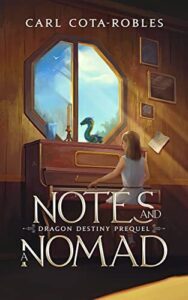 Notes and a Nomad by Carl Cota-Robles:
Notes and a Nomad by Carl Cota-Robles:
Al Hardin is 15 years old and he’s just left his hometown. Haunted by the memory of his mother’s passing, he’s looking for a place to start over and become someone new. But when he meets a talented piano player by the name of Soya, he’s drawn into a conflict against a notorious trio of criminals that will change his life.
Meanwhile, across the vast desert from him, a dragon rider is setting off on a secret mission. 15-year-old Maya dreams of following in his footsteps one day and bonding with her own dragon, but she’ll have to prove herself first. As she takes on an important job for the departing dragon rider, she struggles to maintain an important childhood friendship.
This is the prequel to the Dragon Destiny series. It’s the story of a determined girl navigating friendships and mistakes before becoming a dragon rider. And it’s the story of a boy, forging a new personality that comes to be known as The Silver Bandana.
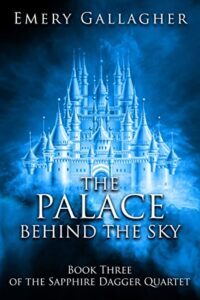 The Palace Behind the Sky by Emery Gallagher:
The Palace Behind the Sky by Emery Gallagher:
Winter in Tandora finds the country locked in a stalemate of war, and Charlie of Windsong remains with the Heir’s Army to support Prince Justinian’s fight for the throne.
Loyalties and allegiances prove tenuous during times of conflict, and a sudden betrayal forces Charlie to flee for her life in the dark of night. She escapes her pursuers with the help of friendly strangers and finds refuge in a fantastical place where she is welcomed as an honored guest. But the longer she stays, the more suspicious she becomes that not all is as it seems in this magical place, and she is uncertain of who she can trust. When the truth is revealed, Charlie finds that the outcome of the war rests on a decision she must make. Her choice leads her on a fast-paced adventure through the Eastern Lands where she encounters danger, subterfuge, and someone from her past.
Her journey to Shala reunited her with her father, and her father’s political scheming brought her back to her home country. Now to save those she cares about, Charlie must depend on her own abilities as she takes on a task that puts her at the center of the battle for the country. On this next adventure, Charlie encounters magic beyond what she has ever seen, steps into her new role as leader of the Order of the Dagger, and takes the future of the Eastern Lands into her own hands.
 The Last Lion of Karkov by Dale Griffin:
The Last Lion of Karkov by Dale Griffin:
“Emotionally compelling protagonists and an action-packed storyline make this a rousing fantasy read” —Kirkus Reviews
“Commanding attention, the novel is propelled toward its gripping end: the world into which the twins were born is not the world that they will leave behind. Intelligent and brave, they inspire a new generation of citizens.” —Foreword Clarion Review
Raised in Karkov, a military, male-dominant kingdom, twins Natalia and Jillian know nothing but battle. When Jillian emerges as the dominant twin and apparent heir to the throne, Natalia, the softer and more diplomatic sister, ceases her military training. As Natalia prepares to marry the prince of her father’s favored Western ally, Jillian is set to become the first woman Lion of Karkov. But things don’t go as planned when the older generation of warriors values her womb over her sword. Suddenly, the role Jillian has fought for all her life is slipping through her fingers…and she’s not about to let it go without a fight.
At first, Jillian wants to destroy the young male warrior that the older generation favors. But soon, the two begin to fall for each other, and dark secrets behind Karkov’s past come to light. Now, Jillian finds herself in the unthinkable position of defending her former rival…and defying her father. Her defiance inspires a younger generation of warriors, who dub her the Lioness of Karkov.
Furious, her father ousts Jillian and the warriors who swore allegiance to her, setting in motion a chain of events that will disrupt everything he swore to protect. As innocent lands suffer invasion, greedy monarchies fall to revolution, and the wedding of the century threatens to live up to its name, Jillian and Natalia must reckon with the consequences of love and war. When four nations converge on a battlefield, one sister must decide whether to embrace the life she always wanted—or stand up for the destiny that was never meant for her.
 Witching With Sharks by Lily Harper Hart:
Witching With Sharks by Lily Harper Hart:
One of the biggest trivia competitions in the world is coming to Paradise Lodge, and Hali Waverly is expecting an influx of guests. What she’s not prepared for is murder.
When a body drops on the resort’s beach, however, she finds herself knee-deep in the investigation along with her new boyfriend Gray Hunter. Unfortunately for her, there are a few too many suspects for her comfort level.
Between the other contestants—a flamboyant group of individuals whom Hali has trouble relating to—and the workers, there’s no limit to the pool of potential killers. Finding the right one isn’t going to be easy.
When you add in the dark merrow, who continue to make their presence known, Hali has her hands full.
All she wants is a little rest and to have a good time. That might not be in the cards though. When it becomes apparent that someone is trying to control the outcome of the competition, all bets are off.
Beaches, bodies, and Bloody Marys? Yup, things are about to get hairy for St. Pete’s favorite witch and shifter.
Oh, yeah, there will be some shark shifters too.
Buckle up, it’s going to be a bumpy ride.
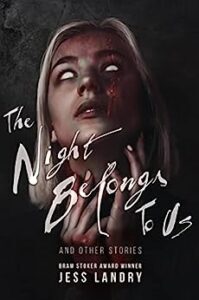 The Night Belongs To Us and Other Stories by Jess Landry:
The Night Belongs To Us and Other Stories by Jess Landry:
Sometimes the deepest wounds are from those we hold the closest.
In her debut collection, Bram Stoker Award-winner Jess Landry blurs the line between genres, magnifying the darkness in the spaces in between, and confronting those relationships that are nearest and dearest to us in the most horrific ways.
A mother and her daughter escape Nazi Germany, boarding the Hindenburg under the promise of a new life. An abused musical protégé discovers that her rage fuels much more than her cello-playing abilities. A hardened police officer finds something unexpected in the rising flood waters of her evacuated hometown. A woman ventures out onto the sea, in hopes of finding a mysterious mist where the dead roam freely. A strange tar infests the home of a young girl, swallowing everything in its wake, including her mother. Two broken women form a tragic bond while searching for a missing person in the dead of winter.
Mothers. Daughters. Sisters. Friends. No one is safe.
This collection of scary short stories is perfect for fans of Gwendolyn Kiste, SP Miskowski, Gemma Files, and Nadia Bulkin, as well as mystery and suspense short stories.
Proudly represented by Crystal Lake Publishing—Tales from the Darkest Depths.
 Cast the First Crone by Amanda M. Lee:
Cast the First Crone by Amanda M. Lee:
Scout Randall’s life has turned from bad to worse. With her boyfriend’s murderous mother on the loose, that means she’s a target. But where will the attack come from?
Scout thought they would have time to figure things out, time to regroup and come up with a plan. She was wrong. The next enemy is on their doorstep.
When a body is found in a remote hunting lodge, a familiar symbol painted on the wall, Scout knows it’s time to go on the offensive. Unfortunately for her, she’s not entirely certain what she’s hunting for.
Is it a human? Is it a vampire? Is it something worse?
Scout and her motley crew of witches and shifters are ready to fight, but when you don’t know your enemy, that’s virtually impossible.
Scout’s answers lie in her past, and the search she thought postponed is suddenly on her. The family that let her go might just be back in the mix. Will they be friends or foes, however?
Big answers are coming fast and furious. Scout’s never been in more danger, and yet if she can hang on just a little bit longer, her past will provide the answers she’s always wanted.
It’s time for the reunion to end all reunions…if Scout can stay alive to see it through.
 Dark and Lonely Water by Graeme Reynolds:
Dark and Lonely Water by Graeme Reynolds:
Dark and Lonely Water is aquatic horror at its finest.”—Gingernuts of Horror
When Samantha Ashlyn is forced to return to her home town to write an article on a series of drownings, she initially resists, finding disturbing similarities to her childhood experiences. However, once she starts looking into the assignment, she finds that things are not what they seem. An ancient evil is rising again, aided by what appears to be a centuries-old conspiracy to keep it hidden. With the help of a disgraced police diver, Sam races to stop the nightmare before more lives are lost. Not realising that her investigation has put herself and those she loves in terrible danger.
Set in Northern England, this folk horror novel is perfect for fans of strong female protagonists, dark humour, conspiracies, mythological creatures, dark fantasy, and thrillers.
Proudly represented by Crystal Lake Publishing—Tales from the Darkest Depths.
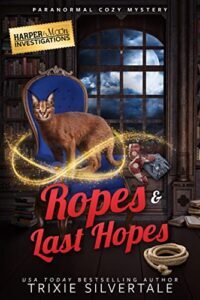 Ropes and Last Hopes by Trixie Silvertale:
Ropes and Last Hopes by Trixie Silvertale:
When a suspicious death takes the life of a friend, our psychic sleuth must expose a killer’s dirty laundry…
Mitzy Moon hopes for a normal day running errands. And this time, she’s determined to get her grandmother’s couture properly cleaned. But her day gets stuck in a spin cycle when she encounters crime-scene tape at the dry cleaner’s and a puzzling murder.
With her only way into the case through an undercover stint in the women’s wrestling league, Mitzy charges ahead with little help from her mentor, Ghost-ma, or her entitled feline. But if the bell rings before she corners the suspect, more lives could end up on the ropes.
Can Mitzy hold a murderer down for the count, or will she be taken out in a lethal smackdown?
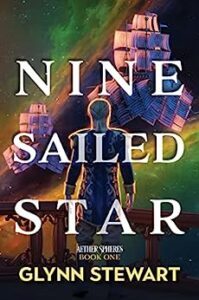 Nine Sailed Star by Glynn Stewart:
Nine Sailed Star by Glynn Stewart:
A captain, exiled for disobeying orders in the heat of a battle against dragons
A shaman, desperate to keep her clan of sailors out of servitude
An archmage who has foreseen the destruction of all worlds
The elvar, with their long lifespans and rigid traditions, condemned Cat Greentrees for fleeing an unwinnable battle to bring news of a new threat. Cat plans to wait out his exile by drinking himself into a stupor, but the words of prophecy dog his heels.
When one of the powerful and revered archmages—a short-lived halvar named Armand Bluestaves—receives a similar prophecy, Cat will need to decide whether to throw away what’s left of his reputation to wage a reckless campaign into the void.
In the void, there are no currents to propel ships. There is only hungry darkness and the ghosts of destroyed worlds. If they want to save all free var of the Spheres, they’ll need to leave everything they know behind.
But first, they need a ship…and a crew.
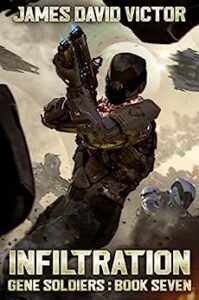 Infiltration by James David Victor:
Infiltration by James David Victor:
The enemy of your enemy is your friend. Maybe.
Carl and his team have been sent on a desperate mission to infiltrate the Palacian homeworld and apprehend the queen. When things go wrong, a new enemy emerges and they are faced with a difficult choice, and their only chance of winning the war might be to trust their sworn enemy. If they choose the lesser of two evils will it still mean destruction of the human race?
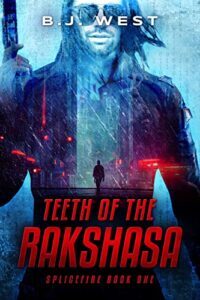 Teeth of the Rakshasa by B.J. West:
Teeth of the Rakshasa by B.J. West:
Revolutionaries, thieves, or terrorists?
Depending on who you talk to, Spider King and his cohorts in the infamous Gordian Net are either criminals or revolutionaries in the ongoing struggle against the corporations that have replaced the federal government of the formerly united States.
Nobody pushes their notoriety as Robin Hoods harder than Spider himself. Arrogant and egotistical, Spider is a veritable rock star of the hacking world. It would be annoying if he wasn’t actually every bit as good as his talk.
Attracted by their reputation, a peculiar client approaches the Gordian Net with an opportunity that could be the score of a lifetime. But what first appears to be a simple hack-and-grab run quickly snowballs into an all-out war with the most powerful tech company in the world.
Spider will have to outthink, outrun, and outmaneuver the most ruthless street operatives in San Francisco without becoming the next victim of a new weapon of unspeakable horror.
March 29, 2023
Indie Crime Fiction of the Month for March 2023

Welcome to the latest edition of “Indie Crime Fiction of the Month”.
So what is “Indie Crime Fiction of the Month”? It’s a round-up of crime fiction by indie authors newly published this month, though some February books I missed the last time around snuck in as well. The books are arranged in alphabetical order by author. So far, most links only go to Amazon.com, though I may add other retailers for future editions.
Our new releases cover the broad spectrum of crime fiction. We have cozy mysteries, small town mysteries, animal mysteries, historical mysteries, Victorian mysteries, Jazz Age mysteries, paranormal mysteries, crime thrillers, action thrillers, spy thrillers, psychological thrillers, romantic suspense, police officers, FBI agents, private investigators, amateur sleuths, spies, dark secrets, blackmail, mysterious widowers, wrongfully accused suspects, deadly circuses, deadly writing retreats, children in dangers, crime-busting witches, crime-busting socialites, crime-busting reporters, crime-busting photographrs, crime-busting cats, murder and mayhem in London, Louisiana, Maine, Los Angeles, Yorkshire and much more.
Don’t forget that Indie Crime Fiction of the Month is also crossposted to the Indie Crime Scene, a group blog which features new release spotlights, guest posts, interviews and link round-ups regarding all things crime fiction several times per week.
As always, I know the authors at least vaguely, but I haven’t read all of the books, so Caveat emptor.
And now on to the books without further ado:
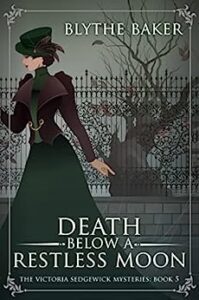 Death Below a Restless Moon by Blythe Baker:
Death Below a Restless Moon by Blythe Baker:
When Victoria Sedgewick’s cousin falls under suspicion for a crime she did not commit, Victoria must protect her. But with a new danger arising at home and trouble threatening her friendship with Branwell Keats, will Victoria be too distracted to prevent a horrific tragedy?
Reese Link is determined to do right by her deceased older brother, to fill his shoes in the local police department, and to avenge his murder. She also wants to make her father, a local lobsterman, proud. But the local force is male, and close-knight, and Reese soon learns that being accepted won’t be so easy.
Small town life on a harbor in Maine can be rough. Winters can be cruel and stretch forever, while the working class who inhabit the harbor suffer no fools. Reese knows this town like the back of her hand—but when she teams up with a State police officer, she quickly realizes she’ll have to branch out to other areas, way out of her comfort zone. She will have to learn quickly about all regions of Maine, as she hunts deadly killers wherever they may take her.
All along, she must fight her own demons, shake off the heaviness of her childhood, the depression of this town, and ask herself: is she good enough?
 Murder Foretold by Beth Byers:
Murder Foretold by Beth Byers:
Once again, Vi and friends are out and about. This time, they’ve come to a lovely little seaside carnival to visit friends they haven’t seen in a while.
They watched the clowns, witness the acrobats, visit the strange and unusual, and invite the psychic to a small party. Instead of a journey or a windfall, they’re told to beware. Is it a surprise their minds turn to crime? Hardly. And when a murder takes place, they have to follow the steps of what happened and prepare for the most unsuaul crime they’ve seen yet.
A FAME-OBSESSED LOS ANGELES POPSTAR MUST CONFESS TO A DARK SECRET FROM HIS PAST—A SECRET SO TERRIBLE IT COULD DESTROY EVERYTHING HE’S WORKED FOR—IF HE IS TO SAVE THE LIVES OF HIS LOVED ONES.
Chris Flowers, one of the most famous and beloved popstars in the world, wants nothing more than to keep playing shows and creating art for his dear fans. Nearly finished with an album, and only days from playing a major show, Chris receives a fateful phone call threatening to expose a dark secret of his past that could ruin him. The sinister voice demands Chris to “Confess” or else… When the lives of loved ones from Chris’s past—the very people he left behind to pursue stardom—become involved, Chris must decide how important his career truly is for him—and if he’s willing to sacrifice lives for it.
You can’t believe all of them, but can you trust any of them?
Widower Kane Black is still ruinously married to his late wife, Lily. Grief has hollowed him… until he sees a woman with his wife’s inimitable beauty on the streets of Manhattan. He whisks her up to his towering penthouse, protectively under guard, nestling her in dark opulence where Lily’s memory is a possessive beguiling force.
Aliyah, Kane’s mother, deals in science. There are too many questions, too few answers, and too much at stake. “Lily” has dangerous control over Kane and there can be only one queen on the throne.
Amy, Kane’s sister-in-law, has been bloodied by deceit and betrayal, and she’s devolving into murderous rage. She’s paid too high a price and now intends to claim what she’s owed.
Three women, linked by buried secrets, circle the man who unquestioningly accepts the return of his beloved long-dead wife. Kane is happier than he’s ever been, and he’ll do anything to stay that way.
Beckett Rousseau is the firstborn son of one of New Orleans’ most prominent families. He’s the quintessential golden boy—great looks, money, and a political career in his future—until his wife murders him. Or at least that’s what everyone thinks.
Athena Durand is still reeling from her murder conviction but now that it’s overturned, she’s at a loss on how to proceed with her life. As long as people still believe she’s guilty, she has no future in Louisiana and more importantly, she wants to know who killed her husband. When she hears about Fortune’s exploits, Athena knows she is the one person who might be able to give her answers, and her life back. But too many people are harboring secrets about Beckett’s life and death, including Athena.
Can Fortune sort through the half-truths and lies to discover the truth? Or did the jury get it right the first time?
 New Girl in the Falls by Elle Gray:
New Girl in the Falls by Elle Gray:
Searching for a fresh start and a serene place to heal from both mental and physical wounds, Agent Spenser Song found herself answering the job posting for the quaint town of Sweetwater Falls…
After a series of tragedies turned her world upside down, FBI Agent Spenser Song felt like a woman adrift in a sea of chaos.
Her brush with death and the tragic murder of her husband left her questioning everything in her life.
And when it became clear that Bureau politics will trump justice, Spenser realized she needed a fresh start.
Looking for a slower pace and needing to heal, Spenser is hired on to be the sheriff in the idyllic town of Sweetwater Falls.
The town is everything her best friend said it would be and all in the Falls was seemingly perfect.
With the exception of her cantankerous landlord, Ryker Makawi, a former Navy SEAL with issues and a past of his own.
When a local woman is murdered, the case proves to be far from simple and Spenser finds herself forced to work with the ill-tempered Ryker.
With her past trying to reach into the present to pull Spenser into a cold dark grave.
Spenser soon realized that the chaos she fled from had found its way back into her life.
Spenser Song came west to find peace. But the new girl in the Falls soon finds herself in the fight of her life.
 Witching With Sharks by Lily Harper Hart:
Witching With Sharks by Lily Harper Hart:
One of the biggest trivia competitions in the world is coming to Paradise Lodge, and Hali Waverly is expecting an influx of guests. What she’s not prepared for is murder.
When a body drops on the resort’s beach, however, she finds herself knee-deep in the investigation along with her new boyfriend Gray Hunter. Unfortunately for her, there are a few too many suspects for her comfort level.
Between the other contestants—a flamboyant group of individuals whom Hali has trouble relating to—and the workers, there’s no limit to the pool of potential killers. Finding the right one isn’t going to be easy.
When you add in the dark merrow, who continue to make their presence known, Hali has her hands full.
All she wants is a little rest and to have a good time. That might not be in the cards though. When it becomes apparent that someone is trying to control the outcome of the competition, all bets are off.
Beaches, bodies, and Bloody Marys? Yup, things are about to get hairy for St. Pete’s favorite witch and shifter.
Oh, yeah, there will be some shark shifters too.
Buckle up, it’s going to be a bumpy ride.
 Terms of Extraction by Ethan Jones:
Terms of Extraction by Ethan Jones:
How would you decide the terms of an extraction?
Jack Storm is facing conflicts on all fronts. While trying to bring his family back together, he must deal with a suspicious extraction where the terms are constantly being manipulated. Not knowing who is pulling the strings, Jack has had enough and determines it’s time to do this on his own terms…
Find out how Jack pulls off his most politically charged extraction yet.
 Cast the First Crone by Amanda M. Lee:
Cast the First Crone by Amanda M. Lee:
Scout Randall’s life has turned from bad to worse. With her boyfriend’s murderous mother on the loose, that means she’s a target. But where will the attack come from?
Scout thought they would have time to figure things out, time to regroup and come up with a plan. She was wrong. The next enemy is on their doorstep.
When a body is found in a remote hunting lodge, a familiar symbol painted on the wall, Scout knows it’s time to go on the offensive. Unfortunately for her, she’s not entirely certain what she’s hunting for.
Is it a human? Is it a vampire? Is it something worse?
Scout and her motley crew of witches and shifters are ready to fight, but when you don’t know your enemy, that’s virtually impossible.
Scout’s answers lie in her past, and the search she thought postponed is suddenly on her. The family that let her go might just be back in the mix. Will they be friends or foes, however?
Big answers are coming fast and furious. Scout’s never been in more danger, and yet if she can hang on just a little bit longer, her past will provide the answers she’s always wanted.
It’s time for the reunion to end all reunions…if Scout can stay alive to see it through.
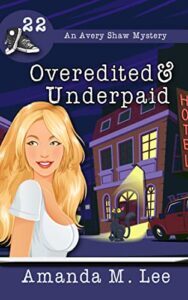 Overedited & Underpaid by Amanda M. Lee:
Overedited & Underpaid by Amanda M. Lee:
Avery Shaw thought she’d seen it all. Then she gets the sort of call she never expected.
Buried in a part of the city she never visits, across the road from the Dairy Queen of all places, is Antique Dolls. It’s a niche strip club featuring dancers over the age of 40 … and a very unique clientele.
When a masked intruder comes barreling into the club firing a gun and hits the owner, Avery is intrigued. When she gets to the hospital and hears that the local police secreted away a politician under the cover of flashing lights and jurisdiction problems, she’s practically frothing at the mouth.
Finding a motive for the shooting should be easy, but when a secretive lifestyle minister inserts himself into the investigation, Avery is left spinning. He’s got a colorful past and an army of followers willing to fight for him.
What he doesn’t have is Avery Shaw. She’s determined to uncover the truth, even if it means putting herself in danger. When Grandpa and Mario decide to help—Mario going as far as to position himself as an undercover dancer—Avery has more backup than she bargained for.
Information is coming at her from all sides, and so is danger.
Avery Shaw doesn’t lose. This time, however, there might not be a winner.
Ever since her husband disappeared seven months ago and it came out that he’d been embezzling funds from the town, pet photographer Kiki Long has been keeping a low profile.
But now it’s time to focus on creating a new life for herself.
Risking the wrath of the town’s residents, Kiki attends the annual Pride Falls Fair where she’s regarded with a mix of animosity, curiosity, and pity.
When a participant in the pie eating contest drops dead due to poisoning, Kiki realizes that the pictures she captured at the fair could hold the key to figuring out the mystery of his death. But it’s not like she can go to Sheriff Rockland with them. He still considers her to be a suspect in her husband’s disappearance.
With the help of her cat, Kodak, Kiki sets out to prove that her friend, who baked the deadly pie, did not poison it. Can she catch the killer? Or will this new development be what lands her in prison?
 The Girl on the Retreat by A.J. Rivers:
The Girl on the Retreat by A.J. Rivers:
The faster you run, the longer you survive…
After participating in a fundraising run, FBI agent Emma Griffin is invited to a week-long retreat.
Upon her arrival, she is instantly captivated by the beautiful yet eerie surroundings of the remote resort.
Sadly her time at the resort is soon met with misfortune and strange phenomenon.
When people start going missing and the guests start acting strange, Emma gets the sense that no one at the retreat is telling her the truth.
And as Emma attempts to uncover the mystery of the resort, she finds herself becoming a pawn in someone’s twisted game.
In a maze full of murderous traps, the only way to survive is to run.
 Ropes and Last Hopes by Trixie Silvertale:
Ropes and Last Hopes by Trixie Silvertale:
When a suspicious death takes the life of a friend, our psychic sleuth must expose a killer’s dirty laundry…
Mitzy Moon hopes for a normal day running errands. And this time, she’s determined to get her grandmother’s couture properly cleaned. But her day gets stuck in a spin cycle when she encounters crime-scene tape at the dry cleaner’s and a puzzling murder.
With her only way into the case through an undercover stint in the women’s wrestling league, Mitzy charges ahead with little help from her mentor, Ghost-ma, or her entitled feline. But if the bell rings before she corners the suspect, more lives could end up on the ropes.
Can Mitzy hold a murderer down for the count, or will she be taken out in a lethal smackdown?
 Winter’s Rescue by Mary Stone:
Winter’s Rescue by Mary Stone:
Nice girls finish last. Bad girls finish dead.
When Private Detective Winter Black-Dalton receives a slew of messages from a mother desperate to protect her children after a traumatizing divorce, she takes the case without hesitation. Not only is it a welcome distraction from unpacking boxes, but Winter hopes to assuage the guilt still fusing her to her past.
She should have known better.
A crayon drawing of guns and “nakid notty girls” by her client’s five-year-old daughter hints at the wealthy and powerful father’s depraved activities. When the man in question warns Winter off the investigation, he reeks of cunning. But she has no hard facts, only impressions. And with no FBI badge to open doors, she needs to get creative.
But the more Winter investigates, she fears something far more sinister lurks beneath the surface. And when local call girls mysteriously disappear, Winter must risk it all to save other young women from the same fate.
The mystery and suspense continue with Winter’s Rescue, the second book in the Winter Black Season Two series, a thrilling ride that will make you realize things aren’t always as they seem. Sometimes they’re much worse.
March 27, 2023
Non-Fiction Spotlight: Brian W. Aldiss and Robert Holdstock’s Mythago Wood: A Critical Companion by Paul Kincaid
Hugo season is upon us and nominations for the 2023 Hugo Awards have opened, so it’s time for another Non-Fiction Spotlight. For more about the Non-Fiction Spotlight project, go here. To check out the spotlights I already posted, go here.
For more recommendations for SFF-related non-fiction, also check out this Facebook group set up by the always excellent Farah Mendlesohn, who is a champion (and author) of SFF-related non-fiction.
Today’s Non-Fiction Spotlight is a double spotlight for two different, but very worthy works of SFF-related non-fiction. Therefore, I am pleased to welcome Paul Kincaid, author of Brian W. Aldiss and Robert Holdstock’s Mythago Wood: A Critical Companion, to my blog today.
Tell us about your book.
Through one of those quirks of publishing, I had two books out in 2022. This was in part because the first was, I think, a little later than originally intended, and the second was short and written to a very tight deadline. The first, Brian W. Aldiss, is part of the Modern Masters of Science Fiction series from Illinois University Press; the second, Robert Holdstock’s Mythago Wood: A Critical Companion is part of the New Canon series from Palgrave. Both, therefore, conform, at least partly, to the demands of their particular series.
Brian W. Aldiss is, as you might expect, a critical study of the science fiction of Brian Aldiss, mixed in with a little biography for context. It is, for instance, significant that the only novel he wrote in which the central character is in a lifelong, happy, monogamous marriage was Greybeard, which was written after the breakup of his first marriage and the beginning of his relationship with the woman who would become his second wife. It is also, noticeably, a novel about a world without children, and his own children from his first marriage had been taken away from him and he believed he would never see them again. As you might guess, I firmly believe that a thorough understanding of creative work must, as bedrock, include an understanding of the circumstances in which that work was created.
Robert Holdstock’s Mythago Wood: A Critical Companion, on the other hand, has a much narrower focus. It is all about the first volume in the Mythago sequence, examining the themes that can be detected in the work. It covers a lot of ground within a short space, ranging from the experiences of Holdstock’s grandfather in the First World War, to the nationalist leanings of interwar studies in folklore and folk music.
Tell us a little bit about yourself.
I suppose, like many people, I set out with ambitions to become a great novelist. But although I have had a handful of short stories published over the years, I have to admit that I am not a natural fiction writer. When I started writing non-fiction, however, I realised that this was something I could do. My first reviews were published in 1977, and I have been turning out reviews, essays, interviews and other stuff consistently ever since
My first book, as I suppose you might call it, was a 30,000-word history of British sf and fantasy, A Very British Genre, which was published as a chapbook by the BSFA to coincide with the British Worldcon in 1995. And there have been two collections of my essays and reviews, What it is we do when we read science fiction (2008) and Call and Response (2014), both published by Beccon. But it was when I found myself retired about ten years ago that the pace started picking up. I wrote the Modern Masters of Science Fiction volume on Iain M. Banks (2017), which won the BSFA Non-Fiction Award, and The Unstable Realities of Christopher Priest (2020) for Gylphi, as well as the two books we’re talking about here.
What prompted you to write/edit this book?
The short answer is absence. An absence of critical work on Aldiss and an absence of critical work on Holdstock.
Before me, there had been three published books on Aldiss, in 1977, 1984 and 1986. But 1985 marked the exact mid-point between his first published book in 1955 and his last in 2015. In other words, none of the books about Aldiss covered more than half of his career. I found that hard to believe, given that he is one of the most important figures in post-war British science fiction. I felt there needed to be a new, up-to-date appraisal of his entire career, and since no-one else seemed to be interested in doing it, it seemed to fall to me.
Now there is a good reason why nobody else was picking up the gauntlet on Aldiss: he is very hard to write about. In fact, I would go further and say he is a nightmare; the look of pity on John Clute’s face when I told him what I was going to do really says it all. Yes, he wrote some of the best and most important novels in the history of British science fiction, but he also wrote some of the worst. One of the problems I have with all three of those earlier books about him is that they came close to being hagiographies. They took him at his word on everything, and they praised extravagantly books that I felt did not deserve such praise. So I had to negotiate a very tricky path, finding what felt to me like the right balance between praise and criticism, and trying to identify the truth from the myths that Aldiss himself would spin. It is, of course, up to others to decide how well or badly I achieved my aim, but I hope it is the sort of judicious assessment that Aldiss deserves.
As for Holdstock, there is one previous collection of essays, which strikes me as woefully inadequate for such a significant writer. I have long harboured an ambition to write a book on Holdstock much like my book on Priest. I suspect, for various reasons, that is never going to come to pass, so when I got a chance to at least write about Mythago Wood I leapt at the chance.
To me, Mythago Wood is one of the most important and influential works in the history of 20th century fantasy, rivalled, I suspect, only by The Lord of the Rings by J.R.R. Tolkien and Little Big by John Crowley. It is a relatively short book, and yet it is packed full of mysteries and ideas that have had a profound effect on the fantasy that came after. It is no surprise that the Best Novel Award from the British Fantasy Society is called the Robert Holdstock Award.
I don’t think I realised, when I set out to write a book-length study of this one novel, just how much there was to disinter. But it was one of the most satisfying things I have ever written.
Why should SFF fans in general and Hugo voters in particular read this book?
I suppose the arrogant part of me wants to answer: because they are such good books, readable, engaging and revealing.
But the real reason is that my subjects, Aldiss and Holdstock, are absolutely essential figures in the history of science fiction and fantasy. Literally, you cannot understand, you cannot appreciate, the development of our literature over the last half-century and more without Aldiss and Holdstock.
Among other things, Aldiss, along with J.G. Ballard, so shaped the British New Wave that it is conceivable that there wouldn’t have been a New Wave without him. Yet at the same time he was instrumental in celebrating space opera and hard sf, through the numerous anthologies he edited alone or with Harry Harrison, at a time when that older tradition of science fiction was under threat from the New Wave. And that odd combination of the new and the old led to him writing the first narrative history of science fiction, Billion Year Spree, which has had a profound effect on the way the character and development of science fiction has been seen ever since.
Holdstock, meanwhile, cast the way myth and imagination shape our interaction with the world around us in such a startling new light that it changed the way that fantasy is written, and has had an extraordinary influence on writers as varied as Graham Joyce and Lisa Goldstein.
Do you have any cool facts or tidbits that you unearthed during your research, but that did not make it into the final book?
I am parsimonious in things like that, all the tidbits I unearth I find a way of integrating into the book. Though it is in the way of things that some of these tidbits end up being more noticeable than others. Reviews of the Aldiss book by women, for instance, have tended to focus on what I call his priapic masculinity; which was certainly there, a reprehensible aspect of both his life and his fiction. But among other things I see this as a pointer to something that has attracted rather less attention. I think Aldiss saw himself as the new H.G. Wells, and not just in the innumerable times that he echoed or referenced Wells in his work. He saw parallels: they were both from the same sort of lower middle class background, their fathers were shopkeepers, they were about the same age when they first got published, they married twice but had numerous other sexual relationships (I suspect Aldiss thought that Margaret should be as tolerant of these liaisons as Jane, though reading between the lines of his autobiography there seem to have been a number of estrangements between them), and they each had a major if unexpected success with a work of history. To what extent Aldiss tried to intentionally shape these parallels I don’t know, but the echoes were certainly there.
There was one thing I discovered that surprised me. I had taken on trust the kudos that Aldiss accrued for saving New Worlds magazine by securing an Arts Council Grant. In fact, I learned, the literature panel of the Arts Council had only just been established at the time and they had no idea how they were going to support literature. As a result they simply handed out grants to any literary magazine that asked for one. Aldiss may have been the one to ask, but he was pushing at an open door.
As for the Holdstock book, well, research is a rabbit hole. Once you start asking questions you have no idea how far you will tumble down, or what other worlds you will find down there. Mythago Wood opens with a quotation from Ralph Vaughan Williams (who appears as a character in the second book, Lavondyss) about his discovery of folk music at the turn of the century. I wasn’t entirely sure what this quotation had to do with what followed in Mythago Wood, though I was vaguely aware that some of those on the folk music scene would go on, between the wars, to be associated with Oswald Mosley’s British Union of Fascists. I wondered if this might have any connection to Holdstock’s decision to set the novel in 1947. I began to research and uncovered more than I expected, though to be honest most of that research found its way directly into the book.
SFF-related non-fiction is somewhat sidelined by the big international genre awards, since the Nebulas have no non-fiction category and the Best Related Work Hugo category has become something of a grab bag of anything that doesn’t fit elsewhere. So why do you think SFF-related non-fiction is important?
I have twice been shortlisted for the Hugo Best Related Work award, so I should be rather well-disposed towards it. But I’m not. I’ve ranted about this on numerous occasions in the past, so I’ll keep it brief. The category is a farce, and becomes more farcical the wider they cast their net. A piece of music? Stick it in Best Related. A previous award ceremony? Stick it in Best Related. There is literally no way you can sensibly decide between the apples and orang utans that populate this stupid category, so in a very real sense it is no honour to be nominated.
And that is a shame. Literally so: it shames science fiction! These are the pre-eminent awards for science fiction, and yet they cannot find a way to genuinely honour writing specifically about the subject supposedly being awarded. The BSFA Awards have a specific Best Non-Fiction category, and there are the various academic awards from the Science Fiction Research Association, but there should be a major award for science fiction non-fiction. We are the poorer without it.
Yet this is all at a time when non-fiction about science fiction has never been healthier. Just as science fiction is opening itself up to a wider world and to a greater range of human experience, so non-fiction is exploring further and deeper. Yes there are the usual collections of essays and single author studies (of the type that I have written), but there are also examinations of the Anthropocene, of cultural issues, of the way our literature responds to historical events or political realities. There is wonderful stuff out there which, collectively, shows us how our literature belongs in and shapes the very world we inhabit. It deserves our attention, because it explains our literature to us.
Are there any other great SFF-related non-fiction works or indeed anything else (books, stories, essays, writers, magazines, films, TV shows, etc…) you’d like to recommend?
From my last answer, you might guess that the answer to this is definitively “yes”. In fact, because last year was so personally catastrophic for me, I haven’t read anywhere near as much as I would like. But I could point you, for instance, towards Mark Bould’s amusing and idiosyncratic study of The Anthropocene Unconscious; Brian Attebery’s elegant Fantasy: How It Works (despite his inexplicable overlooking of Robert Holdstock); Mike Ashley’s five-volume history of the sf magazines reached its climax with The Rise of the Cyberzines, I have major problems with these books as history, but as a data set they are invaluable; and there is an intriguing examination of the science fiction of Bob Shaw and James White from an Irish perspective in Space for Peace by Richard Howard.
Looking ahead, this year brings a memoir from M. John Harrison, a collection of reviews from Niall Harrison, but above all there is A Traveller in Time: the Critical Practice of Maureen Kincaid Speller edited by Nina Allen coming from Luna Press. Okay, I know I’m prejudiced, I know I am still devastated by Maureen’s death last September, but I still reckon this long-overdue collection of her work is going to be one of the essential non-fiction books of 2023.
Where can people buy your book?
There is always Amazon: Brian W. Aldiss and Robert Holdstock’s Mythago Wood
Though personally I prefer to shop at uk.bookshop.org: Brian W. Aldiss.
Or in America you might try Powells: Brian Aldiss and Robert Holdstock’s Mythago Wood.
Though it might be simplest to go direct to the publisher. Brian W. Aldiss from Illinois University Press and Robert Holdstock’s Mythago Wood from Palgrave.
Where can people find you?
My website is here: www.paulkincaid.co.uk
My intermittent blog is: ttdlabyrinth.wordpress.com
On social media I am mostly to be found at Facebook: paul kincaid-critic
On Mastodon I am: @paulkincaidcritic@mastodon.social
On Twitter (for now) I am: @pkincaid_critic
Thank you, Paul, for stopping and answering my questions. Do check out Brian W. Aldiss and Robert Holdstock’s Mythago Wood: A Critical Companion to learn more about two crucial writers of our genre.
About Brian W. Aldiss:Brian W. Aldiss wrote classic science fiction novels like Report on Probability A and Hothouse. Billion Year Spree, his groundbreaking study of the field, defined the very meaning of SF and delineated its history. Yet Aldiss’s discomfort with being a guiding spirit of the British New Wave and his pursuit of mainstream success characterized a lifelong ambivalence toward the genre.
Paul Kincaid explores the many contradictions that underlay the distinctive qualities of Aldiss’s writing. Wartime experiences in Asia and the alienation that arose upon his return to the cold austerity of postwar Britain inspired themes and imagery that Aldiss drew upon throughout his career. He wrote of prolific nature overwhelming humanity, believed war was madness even though it provided him with the happiest period of his life, and found parallels in the static lives of Indian peasants and hidebound English society. As Kincaid shows, contradictions created tensions that fueled the metaphorical underpinnings of Aldiss’s work and shaped not only his long career but the evolution of postwar British science fiction.
About Robert Holdstock’s Mythago Wood: A Critical Companion:This book is a detailed examination of one of the most important works of fantasy literature from the twentieth century. It goes through Mythago Wood by Robert Holdstock considering how it engages with war on a personal and family level, how it plays with ideas of time as something fluid and disturbing, and how it presents mythology as something crude and dangerous. The book places Mythago Wood in the context of Holdstock’s other works, noting in part how complex ideas of time have been a consistent element in his fiction. The book also briefly examines how the themes laid out in Mythago Wood are carried through into later books in the sequence as well as the Merlin Codex
About Paul Kincaid:Paul Kincaid is a Clareson Award-winning critic. His previous volume for Modern Masters of Science Fiction, Iain M. Banks, won a BSFA Award. His other books include What It Is We Do When We Read Science Fiction and The Unstable Realities of Christopher Priest.
***
Did you publish a work of SFF-related longform non-fiction in 2022 or are you publishing one in 2023 and want it featured? Contact me or leave a comment.
March 25, 2023
Masters-of-the-Universe-Piece Theatre: “The Prisoner of Castle Grayskull”
It’s time for another Masters-of-the-Universe-Piece Theatre photo story. The name “Masters-of-the-Universe-Piece Theatre” was coined by Kevin Beckett at the Whetstone Discord server.
Like any good castle, the mystical Castle Grayskull from Masters of the Universe also has a dungeon and indeed the Castle Grayskull playset has always been equipped with a practical trapdoor that allows you to drop intruders from the throne room straight down into the dungeon.
However, beneath the regular dungeon of Castle Grayskull, there is also a second, deeper dungeon that extends steadily downwards, because Castle Grayskull sits on top of a bottomless abyss named the Dwell of Souls. This lower dungeon is populated by all sorts of monsters and represented in all versions of the Castle Grayskull playset by a sticker of a metal grate with all sorts of monsters trying to get out. In many ways, this is reminiscent of the portal to the underworld located underneath Castle Joiry in C.L. Moore’s stories “Black God’s Kiss” and “Black God’s Shadow” or the monster-infested dungeon underneath the Scarlet Citadel from the eponymous Conan story by Robert E. Howar. I doubt this is a coincidence, because Masters of the Universe draws a lot of inspiration from vintage sword and sorcery and pulp SFF in general
Unsurprisingly, people have been fascinated by the dungeon sticker and the monsters living underneath Castle Grayskull for forty years now. I mean, it’s monster-filled dungeon beneath a castle, so who wouldn’t be fascinated by what’s down there? However, little was known about the creatures that live beneath Castle Grayskull until very recently.
The first of the dungeon monsters to receive a name and a backstory was the one-eyed tentacled monstrosity known as the Orlax of Primeria, seen in the top left corner of the dungeon grate sticker. The Orlax appeared in part 2 of Masters of the Universe: Revelation, where Duncan is locked up in the dungeons of Castle Grayskull by Skeletor. The Orlax is imprisoned in a hole undeneath Duncan’s cell and occasionally makes a grab for Duncan. Initially, the two prisoners are wary of each other, but when Duncan helps the Orlax after Skeletor needlessly hurts the creature, they team up to escape. The Orlax was last seen gobbling some of the lesser Evil Warriors (Clawful and Blade) before swimming off to live their best tentacled life. Furthermore, the Revelation prequel comics revealed that the Orlax was not evil at all, but a being from another dimension trying to warn Eternia of impending peril, only that their attempts to communicate via a psychic link caused those they touched to fall into a coma and accidentally killed the young son of King Grayskull, which is why the poor thing ended up in the dungeon underneath Castle Grayskull.
There actually was a toy made of the Orlax of Primeria – or rather part of them, a tentacle reaching out of the dungeon grate – but it was released as part of a convention exclusive Castle Grayskull expansion set and is very difficult, not to mention expensive, to find, so I’ll eventually crochet my own Orlax with flexible tentacles.
The next dungeon creature to receive a name, a backstory and a toy is the frog critter seen on the bottom left of the sticker. The creature is called Frog Monger and was sold as an exclusive action figure via Mattel‘s website. I was lucky enough to snag one and recently had him delivered. The mini-comic that came with the figure explains that Frog Monger was once a sorcerer who sold magical weapons to both sides of the conflict between the Snake People and the humanois Eternians. As a result, the Snake People cursed him and turned him into a frog. The human Eternians didn’t want anything to do with him either , because no one likes war profiteers and frog creatures, so the Frog Monger eventually exiled himself to the abyss beneath Castle Grayskull where he lived far from humans and Snake People. It’s basically the fairy tale of “The Frog Prince”, only without a princess and a golden ball.

Frog Monger with a friend in the form of a Schleich poison dart frog.
I really like the Frog Monger figure, because he is so delightfully bizarre. With his jetpack and ray gun, he looks as if he stepped right out of a 1940s science fiction magazine. And indeed I spotted an ancestor of Frog Monger in the interior art for “Gambler’s Asteroid” by Manly Wade Wellman in the Spring 1944 issue of Thrilling Wonder Stories. The artwork is uncredited, but likely by Marco Marchioni, who did the interior art for the rest of this issue. Marco Marchioni was a fascinating guy BTW.
Inspired by this piece of artwork, I decided to stage my own recreation of the scene with my Masters of the Universe figures. Because the frog alien is a lot shorter than the humans in the picture, I decided to pair Frog Monger up with the larger Masterverse figures.
And since I had the figures set up already, I also made a story set during the time, when Duncan is locked up in the dungeons beneath Castle Grayskull in Masters of the Universe: Revelation, after Skeletor took over the Castle, murdered the original Sorceress and turned Evil-Lyn into the new Sorceress.
In the dungeons deep beneath Castle Grayskull:
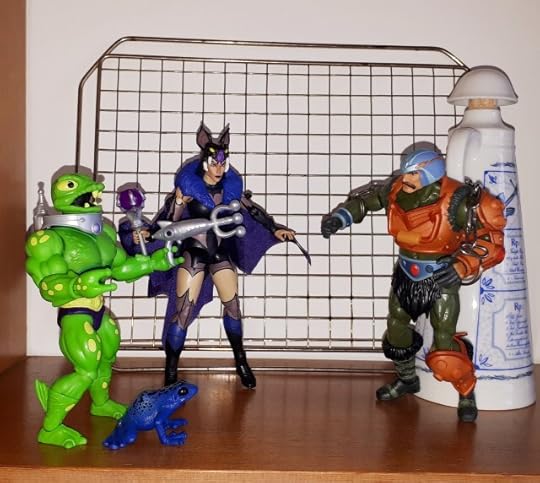 “The prisoner is secure and has been stripped of all his weapons, Mistress. He’s perfectly harmless now.”
“The prisoner is secure and has been stripped of all his weapons, Mistress. He’s perfectly harmless now.”
RIBBIT!
“Let me loose and I’ll show you that I don’t need any weapons to deal with the likes of you!”
“Shall I blast him for his insolence, Mistress?”
RIBBIT?
“No need, Frog-Man. I can handle Duncan just fine. And now get lost. I want to be alone with the prisoner. I’m sure we’ll have much to talk about. And who knows, Duncan, if you cooperate, I might make your incarceration so more comfortable.”
“Forget it, Lyn!”
“Shall I blast him, Mistress?”
“Get lost, Frog Boy! I have everything in hand here. Quite literally.”
 “Come, my amphibian friend. I know enough about the mating rituals of humans to know when we’re not wanted. Here in the dungeons of Castle Grayskull, I have often heard the mating songs of the humans above and I don’t like them.”
“Come, my amphibian friend. I know enough about the mating rituals of humans to know when we’re not wanted. Here in the dungeons of Castle Grayskull, I have often heard the mating songs of the humans above and I don’t like them.”
RIBBIT!
“If you’re going to kill me, Lyn, could you do it now, cause my throat is parched and these chains chafe?”
“Who said anything about killing? Quite the contrary, dear Duncan. We could have so much fun together.”
“I’d rather die.”
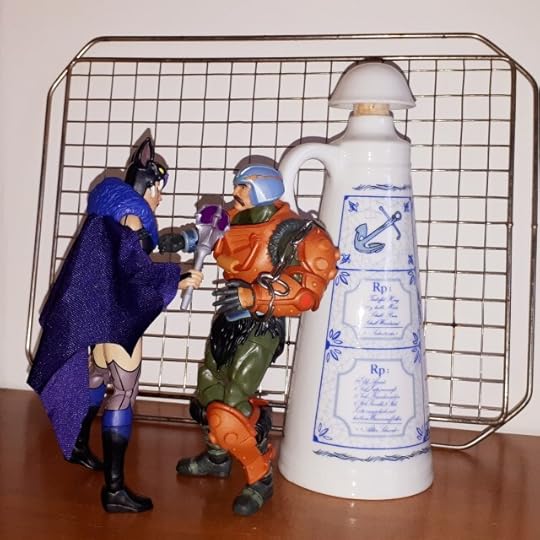 “Still pining for your sweet Sorceress, Duncan? Accept it, she’s gone. And for the record, I did not agree with Skeletor stabbing her. That was entirely unnecessary.”
“Still pining for your sweet Sorceress, Duncan? Accept it, she’s gone. And for the record, I did not agree with Skeletor stabbing her. That was entirely unnecessary.”
“You didn’t lift a finger to help either. And you wasted no time taking her place.”
“Do you think I wanted this? It’s Skeletor’s doing, all of it. He does what he wants and no one can stop him, certainly not me. Especially now that he has the Sword of Power.”
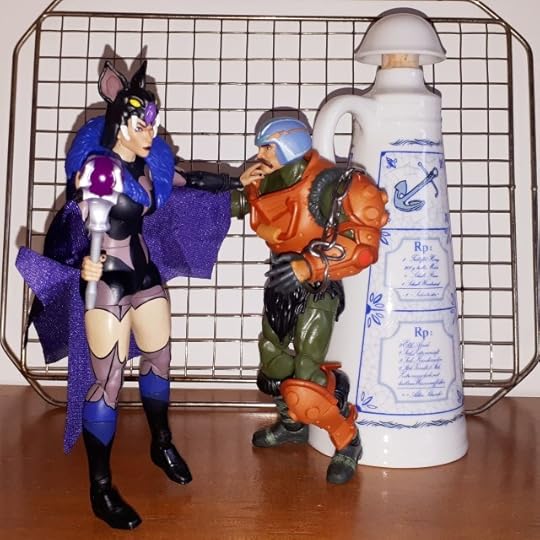 “What’s the matter, Lyn? Did Skeletor hit you again? That revealing outfit isn’t even hiding the bruises.”
“What’s the matter, Lyn? Did Skeletor hit you again? That revealing outfit isn’t even hiding the bruises.”
“He… he changed. It’s that damned Power Sword. It changed him.”
“The Sword of Power doesn’t turn you into a violent arsehole. Skeletor always was like that, even back when he was still Keldor.”
“You don’t know him.”
“I’ve known Keldor for thirty years now, Lyn. He’s always been a violent piece of shit and he’ll never ever change. The Sword of Power brought out the best in Adam and it brought out the worst in Keldor. You know that. We both do.”
“Well, I’m stuck with Skeletor and his delusions of godhood. We all are. Cause he’s not going to give up that sword without a fight and your He-Man has no chance of taking it back, not as puny little Prince Adam. That reveal really was a surprise, by the way. We always wondered why you let Randor’s cowardly son run around with your Heroic Warriors. Who could have guessed that the cowardly little Prince was really He-Man, the most powerful man in the Universe? Tell me, Duncan, did it bother you, to take orders from a puny little boy?”
“Adam is one of the strongest and bravest people I know.”
“He still has no chance against Skeletor, not without the sword. None of us do. We’re all hostages to his insanity now.”
“You could always leave him.”
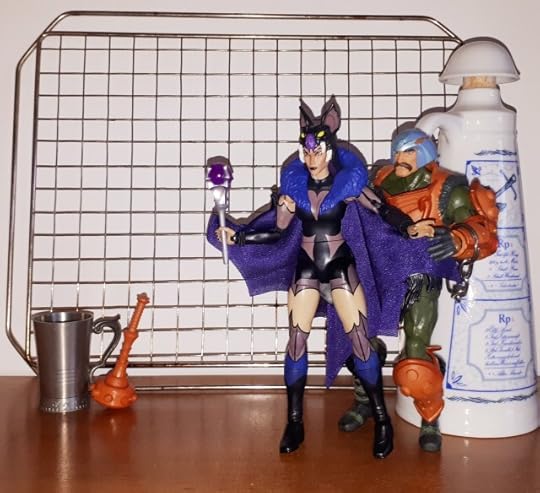 “Leave Skeletor? Ha, that’s a good one. Have you forgotten that I’m the Sorceress of Grayskull now? That means I’m trapped in this cursed pile of rock. I can never leave. I’m as much a prisoner as you are, only that my quarters are nicer.”
“Leave Skeletor? Ha, that’s a good one. Have you forgotten that I’m the Sorceress of Grayskull now? That means I’m trapped in this cursed pile of rock. I can never leave. I’m as much a prisoner as you are, only that my quarters are nicer.”
“Of course you can leave, Lyn.”
“Not in human form. And I don’t fancy spending the rest of my life as a bat. Yes, that’s what I turn into. A bat. I don’t even get to be a soaring falcon like your sweet Sorceress.”
“That’s because she was the avatar of Zoar, while you’re the harbinger of Horokoth. And you can leave in human form. You just have to forego your magic.”
“Yeah right, give up the one thing that gives me some protection against Skeletor, that idiot Tri-Klops and his techno-cult, Mer-Man and – oh yes, your friend He-Man and his Masters of the Universe.”
“Adam would never hurt you. That’s not who he is.”
“No, he wouldn’t hurt me. He’d just lock me up in the royal dungeon, so I’d be exchanging one cell for another. At least here I have a comfortable bed. Which still smells like you, by the way. Musky and masculine.”
“If you help me get out of here, Lyn, I can vouch for you. Adam listens to me. So leave Skeletor and help me get out of here.”
“And then? You’ll go back to Randor, of course. The same Randor who threatened to execute you the next time he laid eyes on you.”
“He was upset. He didn’t mean it.”
“Of course he meant it. He meant every single word. And if Randor takes you back and doesn’t chop off your head the moment he sees you, it’s only because he’s finally realised that he can’t rule his way out of a paperbag without your help and your inventions. Come to think of it, Randor and Keldor are more alike than either of them would ever admit. They’re both arseholes who sit on their thrones and lord over everybody else, while people like you and me get the real work done.”
“Randor is not even remotely like Keldor.”
“No, he’s worse. You were his friend for thirty years. You kept his kingdom running, commanded his armies, raised his son for him and yet Randor turns on you the moment his idiotic son gets himself killed. As if you could have stopped him. As if anybody could have. At least, Skeletor has a place for me in his kingdom. At least, he occasionally remembers that I exist…”
“When he hits you, you mean?”
“Low blow, Duncan.”
“Just telling the truth, Lyn.”
“Well, here’s a truth for you. You don’t need Randor. I don’t need Skeletor. I could break you out of here and then you can help me kick Skeletor out of the castle and retake the sword. And then we can rule Eternia… together.”
“I can’t, Lyn. I’ll help you get rid of Skeletor, but I won’t help you rule Eternia. I swore an oath…”
 “And isn’t that typical of you, Duncan? Always so noble, always so high and mighty, always putting Randor and the realm above yourself and your own needs. You know what? Rot down here and mourn you precious Sorceress! I don’t care. I’ll find my own way without you.”
“And isn’t that typical of you, Duncan? Always so noble, always so high and mighty, always putting Randor and the realm above yourself and your own needs. You know what? Rot down here and mourn you precious Sorceress! I don’t care. I’ll find my own way without you.”
“Lyn, wait! Could you at least give me some water from that pitcher over there, cause my throat is parched? No, I guess not.”
 “Great, Duncan. Well, done. Your best chance of getting out of here just left, because… well, because I couldn’t pretend to accept her offer. Yeah, I probably should have sacrificed myself and my body to Lyn for the greater good. Not that it would be that much of a sacrifice. Lyn’s an attractive woman. Always has been. And I’m theoretically single again. Besides, I could always have pretended to accept her offer and then double-crossed her. Except… well, that’s not who I am. And Lyn knows it. She would have made me swear on my honour to aid her and then I would have been bound by my word to her. Damn, I just hope Teela is all right. And Adam, of course. And Andra and Cringer and Randor and Marlena and yes, even Malcolm. Cause it doesn’t matter if I die down here, as long as my family is safe.”
“Great, Duncan. Well, done. Your best chance of getting out of here just left, because… well, because I couldn’t pretend to accept her offer. Yeah, I probably should have sacrificed myself and my body to Lyn for the greater good. Not that it would be that much of a sacrifice. Lyn’s an attractive woman. Always has been. And I’m theoretically single again. Besides, I could always have pretended to accept her offer and then double-crossed her. Except… well, that’s not who I am. And Lyn knows it. She would have made me swear on my honour to aid her and then I would have been bound by my word to her. Damn, I just hope Teela is all right. And Adam, of course. And Andra and Cringer and Randor and Marlena and yes, even Malcolm. Cause it doesn’t matter if I die down here, as long as my family is safe.”
“You?! But you’re…”
“Dead, yes. But apparently I still have some business to conclude here before I can enjoy my eternal reward in Preternia.”
“Well, according to Adam, Preternia isn’t all it’s cracked up to be and he should know. – Listen, my love, I’m sorry that I couldn’t protect you against Skeletor, couldn’t save you from him. If I could trade my life for yours, I would.”
“It’s all right, Duncan. My tale is done, but you’re still needed here. Watch over Teela and Adam, because they’ll need you. They’re still so young and they’ll need your strength, your wisdom, your guidance and your love.”
“I would do anything to protect our daughter – and Adam, of course – with my life, if necessary.”
“I know. And Duncan, I’m sorry for not being a better partner to you. You’re the best man I know and you deserved so much better than me…”
“But I never wanted anybody but you.”
“Farewell, my Duncan. Try to be happy, because you deserve it.”
“I don’t suppose you can break me out of this place?”
“I’m afraid not. I am but a ghost now and such feats of magic are beyond me. But have no fear. Help will come… from an unexpected quarter.”
“Do you mean Lyn?”

Since I don’t have an Orlax of Primeria or anything that can stand in for the creature, you’ll just have to imagine the Orlax and their tentacles.
“Gone. As if she never was here. And maybe she wasn’t. Maybe I’m imagining things. Hallucinations are not uncommon with prisoners.”
ROAR!
“Oh, shut up, Orlax! Don’t you ever sleep?”
***
Later, in the Sorceress’ chambers:
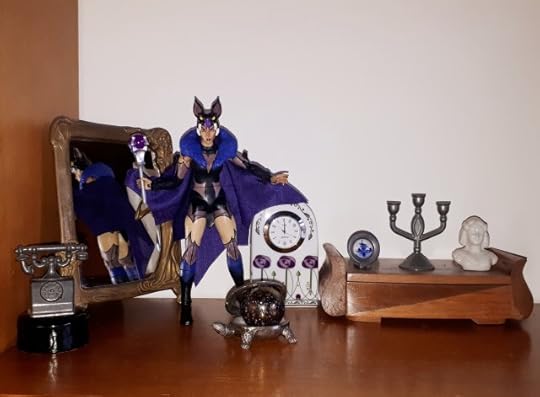 “Alone at last. No Skeletor indulging in his delusions of godhood or gazing into the cosmos, no Duncan being all high and mighty and infuriating, no Beast-Man saying ‘Yes, my lady’ and ‘No, my lady’. Yet I’m stuck here, bound to this blasted castle and surrounded by Teela-Na’s stuff. As well as the things Duncan left behind. I don’t even have a room furnished according to my own taste. I mean, honestly why does everybody like Delftware so much?”
“Alone at last. No Skeletor indulging in his delusions of godhood or gazing into the cosmos, no Duncan being all high and mighty and infuriating, no Beast-Man saying ‘Yes, my lady’ and ‘No, my lady’. Yet I’m stuck here, bound to this blasted castle and surrounded by Teela-Na’s stuff. As well as the things Duncan left behind. I don’t even have a room furnished according to my own taste. I mean, honestly why does everybody like Delftware so much?”
“Hello, Lyn!”
“You? Can’t you stay dead? And for the record, I do not agree with Skeletor stabbing you.”
“I know you don’t agree with Skeletor. And yet I see you wasted no time replacing me, Lyn. Nice outfit, by the way.”
“Oh please! I look like the Salesian streetwalker I swore I’d never be. Do you think I chose this? Any of it? This is Skeletor’s doing, not mine.”
“That’s not how it works, Lyn. The Sorceress is the one who grants the power to the champion, not the other way around. You’re in control. Skeletor only has the power as long as you give it to him.”
“So let me get this straight, Teela-Na. You chose the champion of Grayskull and you picked a snot-nosed kid? Even though Duncan was standing right there.”
“Adam is the chosen one. He was born to wield the Sword of Power.”
“If Prince Adam is the chosen one, then how come that Skeletor can wield the sword and call down the power?”
“Keldor is of the bloodline of Grayskull via King Miro. But many people in Eternia carry the bloodline of King Grayskull…”
“Because the kings of Eternia were busy sowing their wild oats all over the place for centuries. Yes, I know.”
“…but only Adam is the chosen one.”
“I guess that answers Skeletor’s question how Adam was able to call down the power without the sword and then proceeded to beat the holy shit out of Skeletor. Which, for the record, I wish I could have seen. Still, Skeletor can solve his own problems…”
“Adam has called down the power without the sword? That is not good.”
“He used it to beat the holy crap out of the Skeletor and that was very good indeed.”
“You don’t understand. The sword is a modulator to temper the power. Without it, Adam has no control.”
“Again, not my problem. Teela teleported Adam, her friends and herself to Zoar knows where. And unlike you, I’m not going to watch over little Prince Weakling, chosen one or not.”
“The Sorceress has a duty…”
“Yes, but I don’t care. Cause unlike you, I never wanted this job. Which brings me to my next question: So you and Duncan were a couple all those years and you have a kid. And don’t even try to deny it – Teela looks a lot like you and the name is a dead giveaway, too. So why didn’t you marry him?”
“The Sorceress must have no worldly attachments.”
“That’s bullshit and you know it. Duncan is a good man. He loves you and he would have moved into this accursed castle to be with you and he probably would’ve repaired and refurbished the place, too, while he was at it…”
“The Sorceress must not ever be distracted from her duties…”
“What duties? Sitting on that damned throne all day long or gazing into your magic mirrors? Not that I get to do even that, because Skeletor hogs the throne and the magic mirrors. No, Teela-Na, the truth is you’re an idiot. You had the choice of living in the Royal Palace as the wife of the royal Man-at-Arms or being stuck all alone in this rotting ruin, unable to ever leave, and you chose this? Talk about the mother of all bad decisions…”
“Says the woman who hooked up with Skeletor.”
“Let’s get this straight, Teela-Na. I did not hook up with Skeletor. I had a hot and passionate affair with Keldor, when that idiot managed to get his face burned off and his brain along with it. Or do you honestly think I would have chosen to be with Skeletor?”
“Actually yes. After all, you are fated to have a very complicated relationship with Skeletor in every universe out there.”
“In every universe out there? You mean, there’s more than one?”
“There’s an infinite number of universes out there. A whole multiverse of universes, in fact.”
“And I’m stuck with Skeletor in everyone of them? Now that is a terrifying thought. Anyway, Teela-Na, I came here to rest and inhale some of that musky Duncan smell that clings to your bedsheets, not to talk to a ghost or whatever you are. So why don’t you just scoot and go back to Preternia or Subternia or wherever you ended up?”
“Good night, Lyn. Remember, the Sorceress is the one who grants the power. Skeletor is nothing without you. And Lyn, would you do me a favour?”
“Depends. I’m not looking after little Prince Weakling, if that’s what you mean.”
“Adam will be fine. Teela will make sure of that. But Lyn, could you watch over my Duncan for me?”
“Are you honestly asking me to take care of your boyfriend?”
Poof.
“And she’s gone. Typically Teela-Na, perpetually cryptic and infuriating.”
***
It’s strongly implied in Masters of the Universe: Revelation that Evil-Lyn has a liking for Duncan, which has been hinted at elsewhere as well. Most recently, the Masterverse comic mini-series by Tim Seeley and various artists has presented an alternate universe where Duncan and Evil-Lyn team up to fight crime.
What is more, these two have also known each other for years, long before either Adam or Teela were even born. The first episode of the 2002 Masters of the Universe cartoon shows us a young Randor as captain of the guard with Duncan as his lieutenant fighting the forces of Randor’s estranged half-brother Keldor, among them Keldor’s lover Evil-Lyn. We also know that Randor and Keldor fought side by side, before Keldor turned against his brother and became Skeletor, and that Duncan and Randor have been friends since they were teenagers. So all of these people have a lot of history with each other.
It’s also notable that while Skeletor is a terrible person and abuses both enemies and his own allies, he really, really hates Duncan. Of Skeletor is never nice to anybody (except maybe at Christmas), but he’s utterly vicious towards Duncan. This can be seen all the way back to the Filmation cartoons of the 1980s and becomes even more apparent in the 2002 cartoon – where Skeletor beats the crap out of Duncan in the season 1 finale, strips him of his armour, chains him up in his dungeon and abuses him – and in Revelation, where he murders the Sorceress in front of Duncan’s eyes and then strips him of his armour and locks him up in the dungeon again. A lot of characters get captured and locked up by Skeletor at one point or another, but only Duncan ever gets stripped down to his underwear. Of course, stripping Duncan off his armour makes sense, because he has all sorts of weaponry built into it, but there’s also a definite element of humiliation in there. Kevin Smith and writer Eric Carrasco even snuck a castration reference into the respective Revelation episode. As for why Skeletor hates Duncan so much, I suspect he blames Duncan for coming between him and his brother.
The murder of the Sorceress is probably the most heartbreaking moment in a show that’s not short of heartbreaking moments – to the surprise of me and everybody else who didn’t exactly expect heartberaking moments from Master of the Universe of all things. First of all, because there is absolutely no reason for it – the Sorceress has used up all her magic and is powerless at this moment. True, she has insulted Skeletor by calling him “nothing but bones”, but she’s not a threat, neither to Skeletor nor to anybody else. Yet Skeletor kills her anyway, because he feels like it and because he’s a vicious piece of shit.
The first time I watched the respective episode of Masters of the Universe: Revelation, my full attention (and everybody else’s, I bet) was on Duncan and his grief-filled howl of pain as the woman he has loved for twenty plus years dies in his arms. It’s an incredibly powerful moment, probably made even more powerful by the fact that only minutes before, we had gotten definite confirmation that Duncan and the Sorceress were a committed couple. There had been plenty of hints before, of course, going all the way back to the Filmation cartoon of the 1980s and even the old mini-comics, but I personally missed them, probably because Duncan and the Sorceress were parent figures and as a kid you don’t want to think about parent figures doing that sort of thing.
That moment is such a gut punch, because we see Duncan – who is one of the bravest people in Eternia – literally fall apart. He doesn’t even try to fight back – and Duncan had gone one on one with a powered-up Skeletor shortly before – but lets himself be arrested and taken away without any resistance. He’s completely broken at this moment. And Skeletor – as if to prove that he’s an even worse person than we already knew he was – finds the whole thing really, really funny.
But upon rewatching that episode, I realised that Evil-Lyn’s reaction is also extremely interesting. For starters, she’s clearly horrified that Skeletor that just casually murders the Sorceress – remember Evil-Lyn and the Sorceress had worked together to restore magic to Eternia. But as she witnesses Duncan’s reaction, it’s clear that this is the moment where Lyn realises what true love looks like and that she never had anything like that in her life and never will, at least not with Skeletor. That fact that Skeletor not only cracks a joke about Duncan’s pain, but also completely fails to understand what grief even is and why people experience it makes things even worse, because it proves beyond a doubt that Skeletor is unable to feel any normal human emotions. I suspect he wasn’t always like this and that he probably did have feelings when he was still Keldor, but as Skeletor he’s unable to feel anything except hate, anger and pettiness. This is also the moment, where Lyn mentally and emotionally breaks up with Skeletor – though it takes her another two episodes to physically break up with him – and probably also the first sign of the utter despair and hopelessness that makes her try to snuff the entire universe out of existence later in the series.
Both Duncan and Lyn are alive and single by the end of Revelation and Lyn is theoretically reformed, so will the sparks between these two lead to something more? I guess we’ll see once Masters of the Universe Revolution comes out.
That’s it for today, folks. I hope you enjoyed this Masters-of-the-Universe-Piece Theatre Photo Story, because there will be more.
Disclaimer: I don’t own any of these characters, I just bought some toys, took photos of them and wrote little scenes to go with those photos. All characters are copyright and trademark their respective owners.
March 23, 2023
Semiprozine Spotlight: Hexagon Speculative Fiction Magazine
Hugo season is upon us and nominations for the 2023 Hugo Awards have opened, so various Spotlight projects continue with a new Semiprozine Spotlight. For more about the Semiprozine Spotlight project, go here.
Today I am pleased to feature Hexagon Speculative Fiction Magazine and welcome editor J.W. Stebner to my blog.
A note to Hugo nominators: Hexagon Magazine is eligible for the 2023 semiprozine Hugo award.
Tell us about your magazine.
Hexagon SF Magazine is a quarterly speculative fiction literary magazine. The magazine publishes mainly fantasy and science fiction from international authors, with an emphasis on weird, wondrous, and whimsical stories. Since the magazine’s first issue in 2020, over 50 authors have been featured inside 12 issues. Hexagon continues to grow year after year thanks to the support of authors and readers from the short fiction community.
Who are the people behind your magazine?
Hexagon is a ship with only a single pilot. I do all of the reading, editing, graphic design, and promotion of the magazine from start to finish. I enjoy running the magazine alone as it simplifies organization, but I do occasionally wish that I had a team to help me with the tough decisions. But, at the end of the day, I get to be my own boss, choosing the stories I think work best and supporting authors with whom I enjoy working.
Why did you decide to start your magazine?
I decided to start the magazine out of a desire to acquire some editing experience as well as to improve my own writing. Once I created the magazine, I got the chance to connect with an entire community of editors, authors, and readers who were drawn to literary magazines because of a love of great writing and speculative fiction. After releasing the first few issues, I discovered that I really loved editing the magazine, and I decided to shift my focus from writing to editing. Since starting the magazine in 2020, I have edited 12 issues, as well as an anthology with Perennial Press. I have also had the privilege to work with incredible emerging editors as part of my MYRIAD Digital Zines project.
What format do you use for your magazine (print zine, PDF zine, e-mail zine, online zine, podcast, etc…) and why did you choose this format?
The magazine is published in PDF and ePUB formats. I wanted to choose a format which was available online and offline. Readers can download any issue of Hexagon onto their phone, tablet, or computer and read it anywhere they want. They are also great formats for those who wish to share the issues with friends who might be interested in reading the magazine.
Science fiction, fantasy and horror were born in the pulps and short fiction has long been the beating heart of the genre. However, the focus of attention is increasingly moving towards novels and series. So why do you think SFF short fiction is important and worthy of attention?
I think that the reason SFF short fiction is so important is that it is constantly evolving and keeping up with what is happening in the world. Short fiction can be written, edited, and published long before a novel outline is finished. There is something immediate and satisfying about short fiction that does not exist in longer works of SFF. A great short story can be devoured in a single sitting, giving the reader a complete narrative arc in the time it takes to drink a cup of coffee. Whole worlds can be created, inhabited, and destroyed on a single bus ride. There’s something about that that always attracted me to short fiction.
One big problem for SFF magazines is monetarization. Readers are happy to consume short fiction, but they’re often unwilling to pay for it. What are your strategies for financing your magazine and paying your writers and staff?
I funded Hexagon out of pocket for the first six issues until the magazine had enough support through its Patreon to be self-sufficient. Now, subscribers get early access to issues, cover art reveals, and tables of contents, and can choose to sign up for the Writer Tier, which offers short fiction critiques and feedback. Hexagon has now published two subscriber-exclusive year end anthologies that collect everything published throughout the year as well as cover illustration concept art and author interviews. Subscribers also get access to the four MYRIAD Zines edited by emerging editors Kevin M. Casin, Anna Madden, Lyndsey Croal, and Jordan Hirsch.
All of these extra goodies are offered to those who support the magazine. Free fiction is fantastic, but if we want authors to be paid for their work, the money needs to come from somewhere!
Are there any other great magazines, podcasts, editors, stories, etc… you’d like to recommend?
To be honest, I wish I had 30 hours in a day to fit in all of the submission reading I do and to read all of the stories that other mags publish throughout the year. My typical strategy is to find an author I enjoy (usually after reading what they submit to the magazine), search up whatever they have published, and read it voraciously. This strategy takes me to all corners of the literary magazine community. If all else fails, I check out what Alex Brown Charles Payseur, or Maria Haskins have recommended. They have yet to steer me wrong.
Where can people find you?
You can read all issues of Hexagon for free at hexagonmagazine.ca and you can follow us on Twitter @hexagonmagazine to stay up to date on news and announcements.
Thank you, J.W., for stopping by and answering my questions.
Check out Hexagon Magazine, cause it’s a great zine.
***
Do you run a semiprozine and want it featured? Contact me or leave a comment.
March 22, 2023
The Mandalorian and Baby Grogu step aside for “The Convert”
Welcome to the latest instalment of my episode by episode reviews of season of The Mandalorian. Previous installments may be found here.
Warning! Spoilers behind the cut!
When we last met our favourite Clan of Two, Din Djarin had just managed to bathe in the sacred waters of Mandalore and thus redeemed himself in the eyes of his people. However, while taking a dip in the sacred waters, Din was pulled under by something and needed to be rescued by Bo-Katan. Furthermore, Bo-Katan saw some kind of giant creature in the depths. Could it be…. a mythosaur?
When we next see Din and Bo-Katan, she is sitting on the steps leading down into the sacred waters, keeping a wary eye on the waters, just in case the mythosaur – if it indeed was one – decides to put in an appearance. Din is lying on his back, still passed out, while Grogu anxiously hovers around Daddy.
When Din finally comes to, Bo-Katan tells him that since he has now taken his redeeming bath, they should leave. Din agrees and takes a sample of the living waters. Bo-Katan also asks Din if he saw anything down there. Din replies that all he saw was the chasm he fell into and that he had no idea that the living waters were that deep. Bo-Katan tells him that the waters are not supposed to be that deep and that the Imperial bombing must have caused the chasm to open. She does not mention the mythosaur.
In Bo-Katan’s ship on the way back to Kalavela, Grogu suddenly gets visibly upset. A second later, Din and Bo-Katan are attacked by TIE Interceptors. Bo-Katan assumes that one of the many Imperial war lords she pissed off (remember that she was hijacking and stealing Imperial transports when we first met her) is out for revenge. Din man the guns and manages to shoot down one of them, then executes a daring jetpack jump from Bo-Katan’s ship to launch his own and help her take out the TIE fighters. After some fancy manoeuvering and flying, Din and Bo-Katan take out the TIE fighters between the two of them.
However, just as they think they have dealt with the threat, there is an explosion on the horizon. Turns out that the TIE fighters were only a distraction to keep Bo-Katan busy, while a bunch of TIE bomber bomb Bo-Katan’s Brutalist castle to smithereens. Bo-Katan is understandably pissed off – nobody destroys her home and gets away with it – and goes after the bombers. She manages to shoot down one of them, but then an even larger squadron of TIE fighters shows up, way too many for Bo-Katan and Din to deal with on their own. So Din sends Bo-Katan some jump coordinates to a safe place.
The big question is where did the TIE fighters, bombers and interceptors come from? We know that they don’t normally operate on their own alone deep space, but must have a Star Destroyer or other mothership nearby. And that’s a lot of hardware for a run-of-the-mill ex-Imperial general turned warlord.
However, this question will have to wait until later, because first Din, Grogu and Bo-Katan touch down on the unnamed planet where the Armourer and her sect are hiding out. Din tells Bo-Katan that she will be safe here, because his people are living underground, but that she should keep her helmet on. They are met by Paz Vizla, the portly Mandalorian in the blue armour who really does not like Din and tells him to leave, because he’s an apostate. As for Bo-Katan, she may be the heir to the throne of Mandalore, but this splinter group of fundamentalist Mandalorians don’t approve of her and view her as an apostate, too.
Din insists that he has bathed in the living waters and redeemed himself and that he can prove it. Bo-Katan backs him up – after all, she was there. She also points out that she personally pulled Din from the waters, after he fell into a chasm. She dooes not mention the mythosaur, which is probably wise. More and more Mandalorians appear and escort Din, Grogu and Bo-Katan to the Armourer. Bo-Katan is clearly impressed by the size of the Armourer’s group, especially considering that she only ever had two followers and a droid – at least as far as we’ve seen.
Din hands his vial of magical water to the Armourer, who pours it into her cooling basin. The water in the basin glows blue upon contact with the water from Mandalore – probably some kind of chemical reaction. At any rate, the Armourer is satisfied and declares Din redeemed and one of the tribe again.
To everybody’s surprise, the Armourer now turns to Bo-Katan and asks her if she bathed in the living waters as well. Bo-Katan nods, because she did drag Din from the water after all. The Armourer then asks Bo-Katan, if she removed her helmet since bathing in the waters. Bo-Katan says “no”, which is perfectly true – largely because she was way too busy since returning from Mandalore to remove her helmet.
The Armourer then declares that this means that Bo-Katan has redeemed herself as well in the eyes of the Armourer and may stay with her people. Bo-Katan is surprised, but not displeased. After all, she has just lost her home and her followers and someone clearly wants to kill her, so she needs a place to lie low. The fact that the Armourer has a ready-made army probably hasn’t escaped her either.
Talking of which, once the Armourer has declared Din and Bo-Katan redeemed, the other Mandalorians gather around and start awkwardly patting Din and Bo-Katan onto the back, which is apparently the Mandalorian way of expressing affection.
And that’s it for the adventures of Din Djarin, Grogu and Bo-Katan for this week. Because similar to what The Book of Boba Fett did last year, the bulk of this episode is given over to another character, while our heroes only appear in two book end segments at the beginning and the end.
This is a risky venture, because giving over more than half of one episode to a completely different character and their story only works if that story is compelling enough. It worked in The Book of Boba Fett, because viewers were already invested in Din and wanted to see his story continue. However, this episode of The Mandalorian decides to focus on Doctor Pershing, the cloning and gene-splicing specialist who worked for Werner Herzog’s unnamed Imperial leftover and ultimately for Moff Gideon. Is Doctor Pershing compelling and interesting enough that we want to spend an episode with him?
Amazingly enough, the answer is yes. For while I was never all that excited about Doctor Pershing – a supporting character, if there ever was one – and certainly never wondered about what happened to him after he was captured in “The Rescue”, I also never once thought, “What the hell is this stuff? Gimme Din and Grogu” while watching his story unfold.
When we last saw Doctor Pershing, he barely escaped death at the hand of one of Moff Gideon’s men and was saved and arrested by Cara Dune of all people. Cara probably handed the good Doctor over the the New Republic, because the next time we see him, he is on Coruscant, giving the Star Wars universe equivalent of a TED talk. It’s interesting that TED talks are such an integral part of our culture by now that we now get Star Wars versions thereof.
Doctor Pershing talks about how the premature death of his mother of a preventable disease caused him to embark on his cloning research, how he progressed from pure cloning to gene splicing and how he only wanted to help people, until the Empire perverted his research. However, Doctor Pershing is very, very sorry about everything he did in the name of the Empire and he is so very, very grateful that the New Republic is willing to give him a second chance as part of their amnesty program.
Doctor Pershing’s extensive apologising was the first moment in this capsule story that made me feel that something was very off here. Because in many ways, the very public and subservient apology for past misdeeds, combined with the effusive gratitude towards the New Republic reminded me a lot of public confessions of guilt and subsequent apologies in China during the Cultural Revolution or in other Communist regimes.
After the intergalactic TED talk cum public apology, the glitterati of Coruscant chat with Doctor Pershing, express their interest in his research and their horror at Doctor Pershing having to live in the Outer Rim. A particularly obnoxious couple of wealthy jerks remark that they personally find it hard to keep track of the changing regimes – Old Republic, Empire, New Republic – because it’s all the same to them, proving once again that the worst people in the Star Wars universe are not the Sith or the various ex-Imperial warlords, but the idle rich whose wealth insulates them from the effects of whichever regime is in power. Nor do they much care, because profit can made under any regime. It’s a point that Star Wars has repeatedly made before, in the Canto Bight sequence of The Last Jedi, in the Alderaan scenes in Obi-Wan Kenobi and in the Coruscant scenes in Andor and to a lesser degree the prequel trilogy. Of course, there are exceptions – the Organa family, Mon Mothma, Padme Armidala – but rich people are usually the worst in the Star Wars universe.
After the talk, Doctor Pershing gets into a taxi with an annoying droid driver who asks him intrusive questions about the amnesty program and returns to a place called amnesty housing, where the former Imperials awaiting redemption are forced to live. Amnesty housing looks like a rundown 1970s Brutalist housing estate, a kind of Thamesmead in outer space, showing that Doctor Pershing is occasionally allowed to visit the superficial glitter of the new liberated Coruscant, but that his day to day life is a lot more drab.
To drive the point home, Pershing meets a bunch of other “redeemed” former Imperial personnel hanging out in the courtyard of their Brutalist housing estate. Everybody is forced to wear uniforms and badges that mark them as an ex-Imperials in the amnesty program and they are also only referred to as numbers, their names having been stripped from them. In short, the amnesty program looks damned dystopian and the fact that the various ex-Imperials keep assuring each other how lucky they are and how much worse the other place where they were held was and how much worse the Empire was (and to be fair, amnesty housing is not nearly as bad as the prison from Andor) makes the whole thing even more disturbing.
To his shock, Doctor Pershing recognises one of the ex-Imperials at amnesty housing as a young woman who used to serve as communications officer aboard Moff Gideon’s ship. He even asks her about it, but she brushes off the question with, “It was a terrible time. I don’t want to talk about it.” There’s a brief discussion about rumours that Moff Gideon has escaped from custody and from standing trial for his myriad crimes again and then the conversation turns to a more wholesome topic about what the various ex-Imperials miss from the days of the Empire. Nothing bad or incriminating, just harmless stuff like the lights of hyperspace. Doctor Pershing finally admits that he misses the yellow ration travel biscuits, whereupon the young woman – we later learn that her name is Elia Kane – admits her fondness for the red travel biscuits. Later that night, Doctor Pershing is in his flat/cell, when the doorbell rings. He opens the door and finds a metal box filled with yellow travel biscuits on his doorstep.
We next see Doctor Pershing sitting on a desk in some kind of huge office, filing some kind of data cards. His supervisor – who looks incredibly familiar and I’m sure I know that actor from somewhere – tells him that he saw his TED talk and was very impressed. Though it is also telling that Doctor Pershing, who was after all a top tier scientist, is being given busy work of filing data cards.
Doctor Pershing also has to report to a kind of parole officer cum therapist droid who always asks the same question about whether he is happy and whether he feels any negative or aggressive feelings towards his co-workers or the New Republic. We don’t learn until much later, what the penalty for a wrong answer is, but it’s obvious that it can’t be good.
Encouraged by the other inmates of amnesty housing, Doctor Pershing goes on a date with Elia Kane to take in some of the sights of Coruscant. They take a stroll around a public park – or what passes for a public park on Coruscant – eat glowing popsicles and watch some jugglers and stilt-walkers. The centerpiece of the park is a rock jutting out of the ground, a rock that’s the top of Coruscant’s highest mountain and the only part of the surface that is visible. The top of the buried mountain is not just another bit of the beautiful weirdness that the Star Wars universe excels in, but also a reminder how horrifying city planets like Coruscant and Trantor, the granddaddy of them all, really are.
Of course, my teen self immediately wanted to move to Trantor, when I first read the Foundation novels. Because my teen self loved cities and wanted nothing more than to live in a city, the bigger the better. Cause for a kid from slowly suburbanising rural area, where the bus to the next city only went five times per day, cities were where all the cool stuff was – the shops, the restaurants, the cinemas, the theatres, the museums, the clubs. So of course I wanted to live in a city. And Trantor sounded perfect, because it was the city of cities, of whole planet with just city and none of all the other boring stuff. Of course, as an adult, city planets like Trantor or Coruscant are not just horrifying, but also implausible. Where does the food for all the people come from, if there is no hinterland? If the entire surface has been paved over, where does rain and excess water go? For that matter, if there is hardly any vegetation, how does the atmosphere maintain enough oxygen for humans and other oxygen breathers? These questions are never really answered, but city planets still persist in science fiction, because they are cool. And I would still love to visit Trantor or Coruscant, though I sure as hell wouldn’t want to live there.
Encouraged by Elia, Doctor Pershing tries to touch the mountain top only to be warned off by a tsk-tsking drone droid. Elia laughs and tells Pershing was a joke, but it’s also a warning that it’s probably wise not to trust Elia. Doctor Pershing, however, may be smart, but he’s far from wise. And so he confesses to Elia that he’d love to continue his research, since he believes he could do so much good for the New Republic, that he could really help. Elia encourages him to go for it and maybe pursue his research as a private side project.
During his next visit with the parole/therapist droid, Doctor Pershing casually asks if he might continue his research as a private project. The droid is horrified – after all, Doctor Pershing engaged in cloning research and cloning is strictly forbidden by the New Republic.
When Doctor Pershing tells Elia about this, she asks him what he would need to continue his research. “Not much”, he says, “Just a mobile lab station to begin with.” Elia then tells him that she knows where to get a mobile lab station, but that it’s not exactly legal and also requires leaving their designated area – since it turns out people in the amnesty program are not free to move around as they wish. Doctor Pershing is hesitant and Elia tells him to sleep on it.
The next day at work, Doctor Pershing talks to his supervisor and says that he’s noticed that all the data cards he’s supposed to file are for Imperial equipment that’s all set to be destroyed. Doctor Pershing finds this a massive waste of resources – after all, a lot of the equipment could be repurposed for the good of the Republic. The supervisor, however, won’t have any of that. In order to repurpose some of the Imperial equipment, Doctor Pershing would have to file a petition with some higher up authority and no one from the amnesty program has ever done that and the supervisor isn’t even sure if that’s allowed at all. Besides, they have so much to do decommissioning the entire Rebel fleet that they really don’t have time to bother about the Imperial equipment.
Now considering that the New Republic has been shown to be severely underhanded throughout the The Mandalorian and that the Outer Rim is basically the lawless Wild West, decommissioning perfectly good space ships, whether Rebel or Imperial, seems like an idiotic idea. And historically, the victors of a war or a revolution usually had no problems appropriating and reusing the enemy’s equipment and vehicles.
However, we are also living in an era when sensible proposals and ideas are rejected, when they come from the wrong side. For example, a parliamentary proposal to give all residents of German nursing homes vitamin D supplements free of charge was voted down, because the proposal came from the far right AfD, even though it was a sensible and potentially beneficial proposal. And a lot of Americans and Brits are horrified that there are still several laws dating back to the Third Reich in force in Germany today, even though those laws regulate things like “number of parking places per house or apartment block” or “who provides the electricity meter and who pays for it”, i.e. perfectly useful laws, even though terrible politicians passed them.
His experience at his busywork job have so jaded and disappointed Doctor Pershing that he tells Elia that he’s in. And so we get to the centerpiece of the episode, namely Doctor Pershing and Elia on an illicit mission.
We see them heading to a public transport station in civilian clothes and Doctor Pershing looks about as inconspicuous as Obi-Wan did when rescuing little Leia from an Imperial outpost, namely not at all. Elia, on the other hand, looks a lot more comfortable. Clearly, this isn’t her first time breaking the rules of the amnesty program. She even admits to Doctor Pershing that she’s done this before. After all, where does he think she got the biscuits?
Elia and Doctor Pershing jump the turnstiles and sneak aboard an aerial train. It seems they got away with it, too – clearly the New Republic hasn’t installed facial recognition systems in their trains and public transport station. But then two ticket controller droids arrive. And since Elia and Doctor Pershing have no tickets, because they’re not even supposed to be on this train at all, they’re in trouble. But luckily, Elia has experience with trouble and so she and Doctor Pershing move on to the next car, which requires jumping over a chasm and the electric coupling, because trains on Coruscant have fewer safety features than modern day trains. But maybe that bug is a feature, because the ticket inspector droids can lower a handy bridge of the gap to move from car to car. So Elia and Doctor Pershing have to move on to the next car. And the next, until they run out of train. Luckily, they’ve almost arrived at their destination, so Elia tells the Doctor to jump. It’s certainly interesting that the tensest action scene in this episode involves two people trying to escape ticket inspector droids on a moving train.
As for their destination, it’s a wrecking yard, where disabled Star Destroyer upon Star Destroyer has been parked, waiting to be stripped down and destroyed. Why the New Republic felt the need to do this dirty and space consuming work (and Star Destroyers are huge) on densely populated Coruscant, where space is at a premium, remains an unresolved question?
The wrecking yard is barely guarded, because – so Elia tells Doctor Pershing – the Star Destroyers will all be wrecked anyway and have already been disabled, so who would break in? Of course, I can think of a lot of people who would break in – thieves, scavengers, peddlers, since this is the Star Wars universe, after all. But I guess there are no Jawas or Ugnaughts on Coruscant.
Elia and Doctor Pershing sneak through the darkened corridors of the disabled Star Destroyer and this is the moment where Elia finally introduces herself to Doctor Pershing, telling him that she wanted to do that a hundred on Moff Gideon’s ship, but didn’t dare to.
When they finally find the laboratories, Doctor Pershing geeks out and tells Elia about how thrilled he was the first time he found himself in an Imperial lab with all the equipment he could want. They pack up, when they hear sounds outside. Elia says it’s just the ship settling, but then there are more sounds and it’s obvious that someone else is out there.
Elia and Doctor Pershing make it out of the Star Destroyer, but not out of the wrecking yard. A chopper appears, searchlights hit them and they are surrounded by New Republic cops. Doctor Pershing raises his hands and Elia calmly takes the case with the equipment and carries it away. “It’s a trap. She set me up”, Doctor Pershing cries, but no one is listening.
The next time we see Doctor Pershing, he is strapped to a table in some New Republic facility with sinister looking machinery above his head. Doctor Pershing panics, because he knows what this machinery does. It’s a mind-flayer and it’s used to erase memories. However, the officer in charge, a Mon Calamari who sounds (and later turns out to be) brainwashed tells Doctor Pershing that no, this is a rehabilitation machine, it is used to heal and the experience will be quite relaxing and comforting. Mind-flayers are what the Empire used and the New Republic is not the Empire, even though they apparently did scavenge some Imperial technology after all.
Doctor Pershing’s pleas are for naught, an officer takes his glasses – Doctor Pershing is apparently the only person in the Star Wars universe who wears glasses – and the machine is switched on. In the observation booth, a New Republic officer tells Elia that she did the right thing in turning Doctor Pershing in and that she is a true credit to the amnesty program. Elia asks, if she may watch the procedure. After all, Doctor Pershing was her friend, even if he suffered a relapse. Then, once the officer has left, Elia reaches for the dial of the rehabilitation/mind-flayer machine and cranks it up to the max. Doctor Pershing screams, while Elia casually bites into one of the biscuits he liked so much.
What is Elia’s game here? Is she still working for Moff Gideon? Is she working against him and mindwipes Doctor Pershing to make sure that Gideon can never use his research again? Does Elia even have a choice, especially since she tells Doctor Pershing at one point that she never had a choice? Those are questions for another day.
I have to admit that I expected this episode to focus on Din and Bo-Katan fighting the mythosaur – which apparently is something they’ll do some other time. However, I certainly did not expect to get a thirty-minute 1970s dystopian science fiction film of the type so delightfully parodied in Family Guy embedded into an episode of The Mandalorian. And that’s exactly what “The Convert” is. A depressing 1970s dystopian science fiction film, though there are no turtlenecks.
Now The Mandalorian and The Book of Boba Fett both not only draw on the sources that inspired Star Wars in the first place, but also on movies and genres that were popular before or around the time A New Hope came out. And since the original trilogy not only took a lot of visual cues from 1970s dystopian science fiction films – only that in Star Wars, the rebellion against the system is actually successful – no, George Lucas also made his debut helming a classic dystopian science fiction film in THX 1138 (the 1967 short film version thereof I will review for Galactic Journey next month). So The Mandalorian giving us a depressing 1970s dystopian science fiction film is utterly appropriate. Even the visuals – the drab uniforms and Brutalist concrete – fit perfectly.
I have to admit that when I learned that “The Convert” would be a detour into a largely unrelated story, I didn’t expect to like it very much, especially since “Whatever happened to Doctor Pershing?” was not exactly a burning question in my mind. In many ways, this is the Star Wars equivalent of a Star Trek “Lower Decks” episode, where we focus on supporting characters who also happen to live in this world and whose paths intersect with those of our heroes. Such episodes can work or they can fail, depending on how compelling the characters and actors are. And though I wasn’t particularly invested in Doctor Pershing and the previously unnamed female Imperial officer, Omid Abtahi and Katy O’Brian gave excellent performances as Doctor Pershing and Elia Kane. In fact, I was surprised how much I enjoyed this episode, even though it was not exactly a happy story. But then 1970s dystopian science fiction films are many things, but happy they’re not.
Interestingly, most reviewers like Tor.com‘s Emmet Asher-Perrin, The AV-Club‘s Sam Barsanti and io9’s James Whitbrook were uncomfortable with the story, even if they liked the episode overall. Which is perfectly understandable – after all, “The Convert” is explicitly intended to make you uncomfortable.
A lot of reviewers draw comparisons to Andor, which leant hard into the political side of Star Wars (though Star Wars has always been political) and find that “The Convert” falls short by comparison. Personally, I think this is wrong, because “The Convert” tells a different story.
Andor is extremely political – and note that I liked Andor a lot, even if I didn’t review it here – but its politics are also straightforward: Those guys over there are the bad guys, they’re the fascists, the Empire, so grab a brick and throw it at the nearest cop. “The Convert” is a lot more complicated – and a lot more unpleasant – because it shows us how good guys can become bad guys.
One thing that The Mandalorian has occasionally done – most notably in the season 2 episode “The Believer” – is give us the point-of-view of the Empire. What makes this even more notable is that Star Wars almost never gives us the POV of the Empire and indeed goes out of its way to assure us that mowing down Stormtroopers by the score is okay – they’re just clones, after all. Up to now, The Mandalorian had mostly protrayed the New Republic as well-meaning, but incompetent. “The Convert”, however, shows us the New Republic being fucking terrible.
Now portraying the Star Wars universe as a place that’s always terrible, no matter who is in charge, is a thing that only came in during the Disney era of Star Wars. During the George Lucas era, it was always implied that the Star Wars universe was better once and would be better once again. The perennial cycle of weakening democracy, rising authoritarianism, tyranne and rebellion, rinse and repeat, is a legacy of the Disney era and not one I particularly like.
However, “The Convert” nonetheless remains true to George Lucas’ vision of Star Wars. Because the Empire in Star Wars was never a stand-in for the Nazis (in spite of certain visual cues) or – as Brian J. Morra claims in this very clueless article at CrimeReads – the Soviet Union. It was always us. It was always a western style democracy like the USA or Germany gone bad. The Endor scenes in Return of the Jedi, the movie Brian J. Morra claims is somehow about the Soviet Union, are not only an analogue of the Vietnam War, but they are an analogue of the Vietnam War where the Viet Cong – pardon, the Ewoks – are the good guys. The parallels are not just very obvious, but have been noted in contemporary reviews. And note that Return of the Jedi is nigh contemporary with “If only we’d had Sylvester Stallone or Chuck Norris, we would have won” films like Rambo 2 and Missing in Action, which is utterly remarkable. Honestly, would Lucas have gotten away with what he did there, if the Ewoks hadn’t been cute teddy-bear-like critters?
The original Star Wars trilogy was born out of the frustrations of the Vietnam and Watergate era. The prequel trilogy was a response to George W. Bush and the war on terror and the sequel trilogy was a child of the Trump era. The Empire was never the Soviet Union or the Third Reich, it has always been us. It has always been a western style democracy with checks and balances going bad.
Andor was about the mechanisms of fascism. “The Convert”, meanwhile, shows us how well-intentioned democratic regimes can go bad. The public apologies are reminiscent of Communist systems, particularly the Cultural Revolution in China. But personally, I think that the New Republic as portrayed in “The Convert” is an example of the supposedly well-intentioned, but petty and restrictive left-green streak of authoritarism. It is intrusive policies such as mandating what a garden is supposed to look like, what heating system people are allowed to install into their houses, that every radiator in the house, even in very personal spaces like bathrooms and bedrooms, has to be checked for efficiency, and that people have to renovate or sell their houses, if they don’t meet certain arbitrary standards. And yes, these are all actual policies under discussion in Germany and the EU.
“The Convert” is not a pleasant episode to watch, but it is an important one and one that hammers home a core Star Wars principle: The Empire is us. It has always been us.
March 20, 2023
Fancast Spotlight: Chrononauts
Hugo season is upon us and nominations for the 2023 Hugo Awards have opened, so my Fanzine and Fancast Spotlight project continues as well. For more about the Fanzine/Fancast Spotlight project, go here. You can also check out the other great fanzines and fancasts featured by clicking here. And if you need more Hugo nomination inspiration, also check out my series of Non-Fiction Spotlights and Semiprozine Spotlights.
Regular readers of this blog will know that I enjoy reading and discussing vintage SFF, particularly lesser known works. And so today’s featured fancast is right up my alley.
Therefore, I am thrilled to welcome JM, Gretchen and Nate of Chrononauts to my blog today:
Tell us about your podcast or channel.
JM: Chrononauts is a podcast that delves into the history of science fiction literature, and seeks to discuss more obscure works in tandem with or in relation to more well-known stories and writers. In the beginning, I don’t think we had a very precise vision of what we wanted to do, besides: “Hey, let’s talk about some cool sci-fi books! And maybe we can proceed sort of chronologically through the genre’s history!” As time has gone on I think we’ve gotten a more firm handle on this, but also adopted a somewhat relaxed approach, so that while we are still, roughly speaking, moving forward chronologically, we are also taking many tangential side-steps, and are open to including newer works “out of sequence” as it were, particularly if they match up thematically with something from the past. Since I’ve always been into hunting down obscure treasures, I think one of my goals, from the beginning, was always to highlight things that were lesser-known, either because they simply didn’t get as much promotion or, in some cases, had no exposure in the English-speaking world.
We’re also just friends who like discussing books, and I think that comes through in our podcasts. Also, when I was at university in the early 2000s, I did take a science fiction class, and the professor took an interesting approach, wherein the first half of each class discussed some kind of scientific principle or development, and the second half dealt with stories that were connected to that concept. I thought this was really cool and interesting, and I think a part of me wanted to duplicate, although not too rigorously, that approach. So that’s why sometimes we’ll include a segment of history or science background before we get into discussing a particular work. I think it really helps sometimes to add some interesting and informative context to discussing fiction.
Who are the people behind your podcast or channel?
Chrononauts is JM, Gretchen and Nate, we’re three fans who are interested in science fiction history.
JM: I’ve been a science fiction fan for my entire life, really. I also have a background in English literature studies and went to work for the library for the blind producing books in alternate formats. Now I do work in information technology, but stories have always been one of my primary interests. I first got into the Doctor Who television series when I was ridiculously young, and not long after that, my father introduced me to “A Connecticut Yankee in King Arthur’s Court”, by Mark Twain, and you could say I was hooked. I don’t read only science fiction and some of my favourite books are not considered a part of this genre, but it’s one of my biggest interests; always has been, and in early 2020, I decided I wanted to finally get in on this podcasting thing. The basic idea was initially suggested by another friend, who in the end didn’t have the time to participate, but Nate, whom I’ve known for years, was a natural fit for this and I knew right away that I wanted to ask him to join. It was always in my mind that we should have three hosts, and in late 2021 we were finally able to bring that to fruition again, adding my friend Gretchen to the group.
Nate: My background is in academia (history of electrical technologies) and I’m approaching the podcast from more of an “English major” reading background, despite the fact that I haven’t taken an English class since high school. My favorite authors are Dostoyevsky, Dickens, Proust, Joyce, Balzac, Eliot, Fielding, E. Bronte, Woolf, etc., and while I’ve read some SF/F before starting the podcast, it hasn’t been a huge percentage of my reading habits, and as such a lot of the stuff we cover on the podcast I’m coming to for the first time. I’m a native English speaker, but would consider myself at B2 proficiency in Spanish and A2 proficiently in Russian, so I’ve done a number of amateur translations of stories in these languages for the podcast, and made some attempts at some in Italian, German and Catalan (to varying degrees of success).
Gretchen: I have a background in literature and academia as well; I’m currently working on a thesis for English and will be working on a master’s degree in English and information science by the coming fall. My taste in novels, like my taste in pretty much all media, is pretty eclectic, though I definitely have a deep fondness for science fiction. I’ve been a fan of sci-fi franchises such as Doctor Who and Star Trek since I was young, and started getting into the literature around middle school after reading some Bradbury and Douglas Adams, but there’s still a lot out there I haven’t read, so I’m grateful working on this podcast gives me such an opportunity to do so.
Why did you decide to start your podcast or channel?
JM: Put very simply and briefly: We all love stories, and are all science fiction fans to varying degrees. I think that 2020 will be remembered as a time when, among other things, many peoples’ lives changed; I was certainly going through a very rough personal crisis, and I needed something to do to keep my mind occupied and stimulated. I thought: Why not explore this area of interest, so I can share knowledge, have a good time with friends, and learn things, too.
Gretchen: As JM mentioned, I became a member of the podcast after he invited me to join in late 2020. Since then, the podcast has given me a chance to enjoy and talk about many works of sci-fi I haven’t had a chance to read before. As a college student, I get assigned a good amount of readings, but the podcast provides me with other stories and books to read that I can have fun discussing with friends, and all, of course, without the stress of being graded.
Nate: At the start of the pandemic, JM approached me with the idea. My normal reading was in a bit of a slump as I did most of it on my daily commute via train, which had been disrupted when the world shut down, so a new project to work on was just the thing to rekindle the fire. I’m a librarian by day and love doing these in-depth research dives, so discovering an entirely new world to me filled with hundreds of cool sounding stories from the early days was an absolutely fantastic process, as was trying to organize them in a logical fashion. Doing the interlude music also got me back into composing (also to varying degrees of success).
What format do you use for your podcast or channel and why did you choose this format?
Nate: Our format took a while to arrive at. Honestly, our early episodes are a complete mess. We had no idea what we’re doing. It smooths out as we go, and I think now we’re happy with the current format. We decided to approach science fiction history chronologically in the beginning, so we started off with Lucian’s “A True Story” written in the second century AD, and went through various proto-science fiction works through the Enlightenment before we arrived at Mary Shelley in our second episode. In the latter half of the 19th century, a lot more stories that could fall under the SF umbrella were being published, so from roughly episode 5 forward, we started to focus on the origins of various themes and tropes that play out throughout the genre’s history. We’re a spoiler podcast, but we’ve structured our latest episodes to include non-spoiler discussion at the beginning of each segment, so someone who hasn’t read the work can get a feel for if they’d want to or not. We’ll often include in-depth biographical or technical history segments where we think it’s relevant for the material we’re discussing. We like this format as it allows us to cover a wide range of works, and play similar works off of one another, often pairing a popular work with an obscure one.
JM: It’s definitely a work in progress, but I think we have found a really good groove, now. The format has sort of developed over time.
Gretchen: As a new addition to the podcast, I wasn’t a member while some of the changes were occurring, but since joining, we added, as Nate mentioned, the non-spoiler section for our listeners, and we have also started dividing topics and numerous works related to them over longer spans of time, which has, I think, given us a better ability to cover individual stories more in-depth. It is possible there will be more changes in the future, but for now, the format seems to work quite well.
The fan categories at the Hugos were there at the very beginning, but they are also the categories which consistently gets the lowest number of votes and nominations. So why do you think fanzines, fancasts and other fan projects are important?
Nate: The media interests of my formative years were largely dominated by underground music (metal, punk, noise), where fanzine culture and independent releases were very much a part of the landscape, allowing a community to exist separate from the big corporations. I think its important to have that grass-roots, ground up voice, where people can exercise their creativity in expressing their own interests on their own terms, which can often lend a unique, authentic air in contrast to the top-down approach to fandom that comes from big publishing companies.
JM: It may be cliché to say, but fans keep things alive and thriving. The science fiction fan community started out, pretty much, in the earliest of the SF-oriented pulp magazines, and it gave people an opportunity to share ideas and enthusiasms. Many of these fans also became writers, illustrators, or found some other way to get directly involved. Like Nate, I also have some experience with more underground music subcultures, and I got my first science fiction fanzine when I was eight years old, from the local Doctor Who club. Science fiction seems a particularly appropriate place for fandom and fan outlets to thrive, because it always, at its best, promotes some really passionate discussions and, being a form that’s “obsessed with ideas and speculations”, it makes sense that it’s from these kind of grass-roots community-based initiatives flourish and, in a way, lead the proverbial charge.
Gretchen: I agree with my co-hosts that fan content is important for keeping things thriving and fostering independent communities. As a person born after 2000, I’m acquainted with fandom in the digital age, and I have been and am a part of fan communities in online spaces that create their own projects and content based on the media they enjoy. This is part of a long history of fandom, springing in part from the science fiction community.
In the past twenty years, fanzines have increasingly moved online and fancasts have sprung up. What do you think the future of fan media looks like?
Nate: The media criticism sphere of Youtube has really expanded in the last five years, and in addition to the fanzines, websites and podcasts, I would expect to see a lot more SF/F content in the video essay area in the future
JM: I imagine we’ll be seeing more and more audio and video content, probably on all sorts of platforms.
Gretchen: I, too, believe in an expansion of online fan media in both video and audio formats. Besides more of a shift to online fanzines, there will likely be increasing efforts to find and digitally archive previous projects.
The four fan categories of the Hugos (best fanzine, fan writer, fan artist and fancast) tend to get less attention than the fiction and dramatic presentation categories. Are there any awesome fanzines, fancasts, fan writers and fan artists you’d like to recommend?
Nate: Jess Nevins’ “The Encyclopedia of Fantastic Victoriana” is one of the essential reference works we’ve used, which has now been made available online. “What Mad Universe” is a podcast that covers similar historical stuff to us, but more broadly focused on “genre” media, rather than just science fiction. There’s an awesome Youtube channel called “Quinn’s Ideas” that has these amazing dramatic plot summaries of the Dune books with some incredible fanart.
JM: In addition to the things Nate mentioned, there are other terrific genre literature-oriented podcasts like The Elder Sign, Apocalist Book Club, The Paperback Warrior, Hugos There Podcast, and the Dickheads Podcast. I also enjoy movie podcasts like The Projection Booth and Sci-Fi On Screen.
Where can people find you?
We’re on:
Our episodes: https://anchor.fm/chrononauts (also on Apple, Google, Spotify, etc)
Twitter: @ChrononautsSF
Facebook: https://www.facebook.com/chrononautspodcast
Obscure texts, original translations, episode transcriptions: https://chrononautspodcast.blogspot.com/
Goodreads: https://www.goodreads.com/group/show/1093395-chrononauts
Thank you, JM, Gretchen and Nate, for stopping by and answering my questions.
Listen to Chrononauts, because it’s a great podcast.
***
Do you have a Hugo eligible fanzine/-site or fancast or a semiprozine and want it featured? Contact me or leave a comment.
March 16, 2023
The Mandalorian and Baby Grogu Visit “The Mines of Mandalore”
Welcome to the latest instalment of my episode by episode reviews of season of The Mandalorian. Previous installments may be found here.
Warning! Spoilers behind the cut!
The episode opens not with Din Djarin and Grogu, but with an aerial view of Mos Eisley on Tatooine on the eve of some kind of local festival. Since this is Mos Eisley, the festival involves racing landspeeders. And everybody’s favourite dodgy mechanic Peli Motto is running a scam, repairing damaged landspeeders who their parts stolen by Jawas. She charges the landspeeder owner (here a Rhodian, i.e. Greedo’s species, in very colourful garb) a premium for quick repairs and parts replacement and then turns around to buy the parts back from the Jawas who stole them.
Peli’s lucrative, if not quite legal operation is interrupted by the arrival of Din Djarin and Grogu in their snazzy starfighter (which still doesn’t have a name). She quickly chases away the Jawas to welcome Din and Grogu, who is so happy to see Peli that he uses the Force to somersault into her arms. Of course, Peli babysat Grogu several times, so he knows and clearly likes her. Nonetheless, it is notable that Grogu’s world is clearly expanding and now encompasses people other than his Daddy. We will see more of that later in the episode.
Din has come to ask Peli, if she can procure a memory circuit for IG-11 for him. Unfortunately, Peli cannot procure such a circuit, because IG droids are no longer in production and parts are hard to come by, which is basically what Babu Frik said in the previous episode. However, Peli has the perfect alternative and sells Din a battered R4-D5 droid – in fact, the very same R5-D4 droid that blew a fuse, when Owen Lars tried to purchase him in A New Hope, opening the way for the meeting of Luke Skywalker and R2-D2 and setting the entire plot in motion. Unlike R2-D2, R5-D4 is not an adventurous droid at all, even though Peli persuades Din that he was “built for adventure” and “used to work for the Rebellion” (well, he did, kind of). And because Peli likes Din, she even modifies his snazzy starfighter so that R5-D4 can sit in the doid port, while Grogu gets to ride in the cockpit with Daddy.
Not that I’m not happy to see R5-D4, but I still wonder what the point of the whole plan to resurrect IG-11 was, if Din is so easily persuaded to just use another droid. And considering that Greef Karga offered him a spanking new droid last episode, I honestly wonder what the point of the whole memory circuit excursion was aside from checking in with Peli Motto and giving Amy Sedaris another welcome guest appearance. io9 reviewer Germain Lussier has similar questions.
However, now that the droid issue is settled, Din and Grogu are off on their main mission, namely to visit Mandalore, so that Din can bathe in the sacred waters and be redeemed in the eyes of his cult of fundamentalist Mandalorians. On the way there, Din continues giving Grogu baby’s first lessons in space navigation and points out, “Here is Mandalora, this is Concordia, the moon where I grew up and this is Kalavela, where we visited Bo Katan.” Those lessons will come in handy later in the episode. And by the way, am I the only one who thinks it’s funny that the fundamentalist Mandalorian splinter group in which Din grew up lived on a moon whose name means “unity” in Latin?
We also learn that Din has never actually been to Mandalore, because the planet was bombed to smithereens before he could make the pilgrimage there that used to be expected of all Mandalorians. However, Din assures Grogu that Mandalore used to be a beautiful world, something it very obviously isn’t in its current state. Instead, Mandalore is beset by atmospheric storms, much of the surface is fused into green glass and what remains of the cities is in ruins. The Empire truly did a thorough job destroying Mandalore.
Din lands his starfighter on what looks like a lake of glass and sends out R5 to take some readings and determine if the atmosphere is breathable. R5, who is decidedly not built for adventure, isn’t particularly happy about this, but he does trundle off, only to promptly vanish behind some glass shard rocks. Grogu is clearly worried, but Din assures him that R5 is fine, only for R5’s signal to vanish from the cockpit scanner. So Din seals up his helmet and goes out after him.
It’s nicely shot and tense scene, as AV-Club reviewer Sam Barsanti points out, but I still wonder what the point of it all is. Of course, when planning to explore a planet that was literally nuked from orbit, it makes sense to run an analysis of the atmosphere for radioactivity, toxic substances and possible changes to the composition of the atmosphere, all of which could poison or kill anybody setting foot on the planet. However, why doesn’t Din scan the atmosphere from orbit? Does his ship not have the relevant equipment, even though an atmospheric scanner would appear to be a supremely useful bit of equipment in a galaxy where people are regularly forced to land on not particularly hospitable planets? Or did the magnetic disturbances caused by the Imperial bombing that make interstellar communication impossible also disable orbital scans? Finally. if Din can just seal up his helmet – again a very useful function – why send out R5 and not take the readings himself?
Of course, it all happens for the sake of drama and excitement, like a lot of things in this episode just happen because they’re cool and exciting. And so Din is immediately attacked by Morlock-like humanoids (we later learn that they are called Alamites and used to be native to Mandalore before those weird armoured humans showed up) and barely manages to fight them off with the Darksabre. I’m not the only one who noticed that the Alamites look a bit like the Morlocks from the 1960 adaptation of The Time Machine, by the way. Tor.com reviewer Emmet Asher-Perrin noted the resemblance as well.
Once Din has dealt with the Alamites and rescued R5, he sends the droid back to the ship and fetches Grogu, because Din has by now scanned the atmosphere and realises that the air is breathable and neither radioactive nor toxic. So Mandalore is not cursed, as the Armourer and her cult believe.
Din and Grogu now venture into a cave and come upon a chasm with the civic centre below. Was the civic center buried during the bombing or was it always underground? And why does the supposed civic centre look more like some kind of ruined industrial facility? And what precisely do Mandalorians need a civic center for anyway?
At any rate, it’s a long way down and Din and Grogu navigate the drop via jetpack and floating crib respectively. Once they’ve reached the bottom, they move deeper into the ruins in search of the holy waters. And since this is Star Wars, the ruins are of course populated by random monsters, because there is no ecological niche in the Star Wars universe that is not populated by a random monster. We’ve already met the Alamites and down in the ruins, there are crocodile-dragon hybrids lurking in sewer pipes.
There are also other, far more dangerous threats down here, as Din learns when he finds a Mandalorian helmet in the ruins and makes the mistake of picking it up, which triggers a trap to spring shut. The trap was laid by a weird spidery monster droid with a single eye, which drags Din to its lair, where there’s a pile of Mandalorian armour and weaponry. The one-eyed droid disarms Din and sticks him into a cage on a spit. The big monster droid then opens up to reveal a smaller scittery monster droid, which starts draining Din’s blood.
Now every reviewer praised the monster droid’s creepyness (and indeed it is supremely creepy), but the big question is: What precisely is that droid, what is it doing in the ruins and what does it need Mandalorian blood for? Armour I could understand, since Beskar is one of the strongest materials in the Star Wars universe, but blood? Once again I suspect the answer is that the thing is only down there, because vampire droids are cool.
Grogu climbs out of its crib and tries to use the Force to free Daddy and is almost caught by the vampire droid. Din regains consciousness long enough to yell at Grogu to get out of there and find Bo-Katan.
So little Grogu escapes from the creepy ruins in his floating crib, dodging the flying dragon-crocodile creatures and Force punching an Alamite. He returns to the starfighter and points at the planet Kalavela on the map screen, indicating to R5 that he wants to go there. So Din’s space navigation lessons did pay off.
On Kalavela, Bo-Katan is still lounging on her throne, clearly intending to beat King Randor of Eternia, the Sorceress of Castle Grayskull, Skeletor and several Game of Thrones characters in the informal “Sitting around on thrones” championship. A droid of the same type as K-2SO from Rogue One approached and announced that an unscheduled ship has landed. Bo-Katan looks out of the windows of her Brutalist castle, sees Din’s starfighter on the landing deck and stalks off, declaring that she will deal with him once and for all. Personally, I expected that Bo-Katan would tell Din to get lost and never bother her again, but Germain Lussier points out that it’s also possible that Bo-Katan was planning to kill Din and get back the Darksabre she needs to become Queen of the Mandalorians.
But whatever Bo-Katan was planning to do, her anger evaporates once the canopy opens and Grogu hops out, clearly upset. Bo-Katan orders her droid to plug into R5’s memory to find out where the ship and the droid have been (since Grogu can’t talk enough to tell Bo-Katan what’s up) and takes off to Mandalore with Grogu and R5 in tow to rescue Din.
Based on the trailers, I had expected Bo-Katan to be the main antagonist for season 3, since Din has the one thing she wants and needs most, the Darksabre. That said, Bo-Katan did help Din and saved his and Grogu’s bacon twice in season 2. And though she disapproves of Din and the fundamentalist beliefs of his Mandalorian splinter group, she nonetheless genuinely cares about the welfare of the scattered people she would rule. And so she does not hesitate to come to Din’s rescue a third time.
Bo-Katan is visibly shocked when her ship breaks through the clouds and she finally sees what Mandalore has become. “This used to be a beautiful world,” she tells Grogu, “And my family ruled it all.”
The camera then follows Bo-Katan and Grogu down into the bowels of the ruined city. In many ways, it’s a repeat of the trip we already saw Din and Grogu undertake. However, the repetition also shows how very differently Bo-Katan and Din deal with the threats that face them. And so Bo-Katan does not blunder upon the Alamites like Din, but sense their trap and proceeds to kick Alamite butt. Grogu is clearly impressed. “Did you think your Dad was the only Mandalorian?” Bo-Katan asks the little one.
Bo-Katan is also the one who supplies the name Alamites for the Morlock-like creatures. She tells Grogu that they used to live in the wastelands of Mandalore. And if the Alamites survived the bombing of Mandalore, Bo-Katan wonders who or what else might have survived.
Bo-Katan also asks Grogu how good he is with the Force and tells him that she used to know quite a few Jedi and that they used to get along quite well and fought the Empire side by side. One of those Jedi would be Aksoka Tano, who is of course a friend of Grogu’s as well.
Grogu and Bo-Katan reach the place where the spider vampire droid thing is sucking the blood out of Din. Bo-Katan attacks the droid and the droid fights back. But then Bo-Katan spots the Darksabre lying on the floor, grabs it and begins to dismantle the spider vampire droid. Unlike Din, who has trouble controlling the Darksabre and sometimes seem barely able to lift it, Bo-Katan has no trouble at all. But then, she probably had a lot more practice wielding the Darksabre.
Bo-Katan dismantles the spider vampire droid, but the head and the eye scitter off. She then proceeds to free Din who comes to just in time to warn her of the big trap droid. Bo-Katan makes short work of the droid by slicing it in half with the Darksabre.
We next see her, Din and Grogu, they are sitting on a ledge. The injured Din is resting, Grogu is puttering about and Bo-Katan is making a traditional Mandalorian meal called pog soup for Din. Turns out that Din has never had pog soup due to not growing up on Mandalore. Bo-Katan finds this hard to believe since most Mandalorian kids have pog soup from Grogu’s age on. As for what pog soup is, StarWars.com has a handy recipe for a blended vegetable soup that sounds pretty good actually. That said, I wonder how Bo-Katan came by fresh vegetables and spices in the middle of a post-apocalyptic ruined city. The coconut milk at least could be explicable by “she found a can that survived the bombings”. Maybe Mandalorians carry emergency heat-and-eat packages of pog soup around.
Bo-Katan is eager to get away from the dead planet and offers Din a lift back to Kalavela, but Din refuses to leave until he has bathed in the sacred waters. Bo-Katan tells him that she finds his faith in those old fairytales almost endearing and that there is absolutely nothing special about those waters, but she still agrees to accompany Din, because he’ll never find the waters on his own.
We get an interesting contrast between Bo-Katan who is extremely jaded about all the lore and myths of Mandalore and Din Djarin who not only believes in all the myths, but also takes them absolutely literally. This is partly due to their very different upbringings. Bo-Katan grew up as a daughter of the ruling house and had a privileged look behind the curtain. She clearly does feel a responsibility for her people and wants to reunite them, but she is also jaded and knows that the myths and lore and the bath in the sacred waters (which she was required to take as a daughter of the ruling house) are just opium for the people. Though it is notable that Bo-Katan is not immune to superstition and refused to take back the Darksabre, when Din offered it to her. Meanwhile, Din grew up as a member of a fundamentalist splinter group and believes every single word of Mandalorian lore. “Without the creed, what are we?” he tells Bo-Katan at one point.
When Din, Grogu and Bo-Katan finally reach the sacred waters, there’s basically just some stone steps leading down into murky water as well as a memorial plaque which notes that this is the very spot where Mandalore the Great wrestled and defeated a Mythosaur, which is why the waters are sacred. The whole thing is rather anti-climactic – and Bo-Katan clearly relishes Din’s reaction. So the only reason why Mandalorians take a dip in this specific pool is that the founder of their sect fought and defeated one of the monsters that are so abundant in the Star Wars universe. And indeed, the stylised crest that many Mandalorians have on their armour represents the Mythosaur that Mandalore the Great fought, though Din and Grogu have their own crest, the Mudhorn they fought together all the way back in episode 2. Coincidentally, the fact that fighting giant monsters is so crucial to the Mandalorian history and religion also explains why there is so much fighting of giant monsters in this show.
Anyway, Din wades into the sacred waters in full armour (somehow I doubt it’s supposed to work that way) and begins to recite the Mandalorian creed, when all of a sudden something pulls him under. Bo-Katan does not hesitate, but dives in after Din and rescues him for the second time in this episode. The water is murky, but just before Bo-Katan pulls Din out, she sees a giant eye in the dark water. Could it be… the legendary Mythosaur?
Wow, that was quick. Based on previous seasons, I had expected Din and Grogu to meander about the galaxy some more before finding a memory circuit for IG-11 and then meander about even more before finally taking that redeeming bath in the Mines of Mandalore. At any rate, I didn’t expect Din and Grogu to reach the Mines of Mandalore by episode 2.
At any rate, since Din has fulfilled his quest – though I’m not sure if it counts, because he never finished reciting the creed before the Mythosaur showed up – the rest of the season will deal with something else. Maybe Bo-Katan and Din will team up to reunite the Mandalorians and resettle their old homeworld. At any rate, I did like their chemistry in this episode.
I had also expected Bo-Katan to be the primary antagonist of the season, so it was a pleasant surprise to see her and Din working together and sort of bonding. I also love it that Din continues to be not particularly good at most things and that he needs quite a bit of rescuing. Emmet Asher-Perrin calls Din a damsel in distress here and that’s absolutely right. It’s also a nice reversal of expectations that Bo-Katan is not just the more skilled Mandalorian, but also has to save Din’s arse several times.
All in all, this was another fun episode, even if it left a lot of loose ends, such as “What exactly was the deal with that spider vampire droid?”
March 15, 2023
Remembering John Jakes (1932 -2023)
Writer John Jakes died yesterday aged 90, not quite a month before his 91st birthday.
Most people will probably associate John Jakes mainly with the weighty historical epics that made him a bestseller in the 1970s and 1980s. If you were a kid during that time, John Jakes’ Kent Family Chronicles and North and South were probably on your parents’ bookshelves. They certainly were on my parents’ bookshelves (and still are, in fact).
And even if your parents or grandparents didn’t read John Jakes, you’ve probably at least seen the North and South TV miniseries and its sequels Love and War and Heaven and Hell, which were smashhits in the 1980s that everybody watched. Reruns of the three miniseries – called Fackeln im Sturm (Torches in the Storm) in Germany, because a TV executive claimed North and South sounded like the title of a travel program – still get good ratings in Germany almost forty years later. The Bastard, The Rebels and The Seekers, the first three Kent Family Chronicles novels, were made into TV mini-series as well, though they never had quite the impact that North and South did.
For many years, I mentally shelved John Jakes as a writer of the sort of historical doorstoppers that were immensely popular from the 1960s to the 1980s. John Jakes was very much “parent literature”, enjoyable and interesting enough when you found yourself stuck on a holiday with nothing to read but your Mom’s paperback copy of North and South. His novels were also better researched than many others of the same type – and indeed Jakes was aware of his responsibility as a writer of historical fiction, since he knew that for many people, his books would be the first and only time they ever heard about the historical events they covered. However, Jakes was not really someone whose works I would seek out on my own.
And indeed most obituaries, such as Robert D. McFadden’s from the New York Times and Mike Barnes’ from The Hollywood Reporter, focus mainly on John Jakes as a writer of bestselling historical fiction. Interestingly enough, I couldn’t find any German obituaries at all, even though North and South was immensely popular here in the 1980s. I find this very telling, especially since I found at least five different obituaries for the far more obscure German Romanian writer Richard Wagner (not to be confused with the composer of the same name), who happened to die on the same day.
What is only a footnote in all of the mainstream obituaries is that John Jakes was also an SFF writer as well as a writer of crime fiction, westerns and erotica long before he found success beyond imagination with historical sagas.
I certainly had no idea that John Jakes had written SFF before I came across his name in a review at Galactic Journey and thought, “Wait a minute, the North and South guy used to write SFF?” Turns out John Jakes did not just write SFF, he wrote a lot of it and was also one of the protagonists of the second sword and sorcery boom.
John Jakes debuted towards the end of the pulp era (and indeed was probably one of the last surviving authors of the pulp era) with a story called “The Dreaming Trees” in the November 1950 issue of Fantastic Adventures, when he was just eighteen years old. The story in question is an early work of ecological science fiction and may be read online here. In fact, that story sounds fascinating and I will probably do a Retro Review of it eventually.

Interior art by James B. Settles for “The Dreaming Trees” by John Jakes
John Jakes’ next story “Your Number Is Up!” appeared only one month later in the December 1950 issue of Amazing Stories. More stories appeared in rapid succession in the Ziff-Davis SFF magazines, but also in If, Planet Stories, Imagination and even Galaxy and The Magazine of Fantasy and Science Fiction, at the time two of the most prestigious SFF magazines.
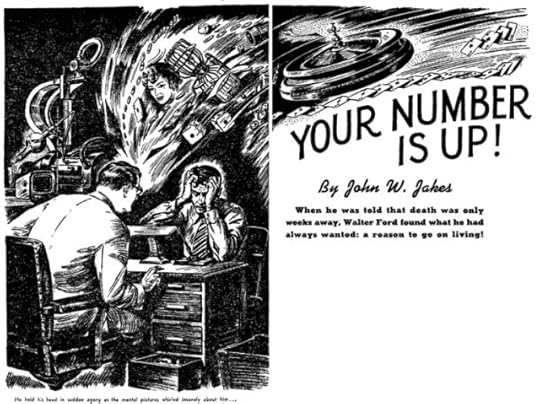
Interior by Edmond Swiatek for “Your Number Is Up!” by John Jakes
A lot of these early John Jakes stories sound quite fascinating – a mix of horror, crime fiction and delightfully pulpy SFF. Here’s one from 1951 which appears to be a murder mystery set on a mansion on Venus. Honestly, I feel Retro Reviews coming on.
At the same time, John Jakes also wrote westerns for the remaining western pulps as well as mysteries, crime fiction, historical adventure fiction (pre-empting his later career mainstays), men’s adventure fiction, TV tie-ins and even erotica. Like many writers of the pulp and early paperback era, John Jakes was a Jack or rather Jakes of all genres. At Dark Worlds, G.W. Thomas traces the seventy year writing career of John Jakes in a three part part post.
John Jakes was a fan of Robert E. Howard’s Conan stories, even though he was only six months old, when Conan of Cimmeria burst onto the scene in the November 1932 issue of Weird Tales. And so he created his own sword and sorcery hero loosely inspired by Conan in Brak the Barbarian, whose adventures initially appeared in Fantastic Stories of Imagination between 1963 and 1965 under the editorship of sword and sorcery champion Cele Goldsmith Lalli (more on her in an upcoming article in issue 1 of New Edge Sword and Sorcery Magazine).
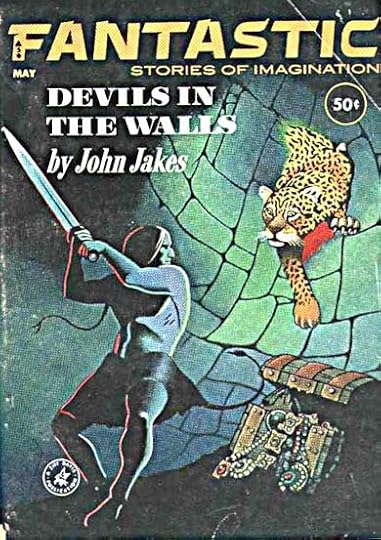
Brak the Barbarian debuted in “Devils in the Walls” in the May 1963 issue of Fantastic
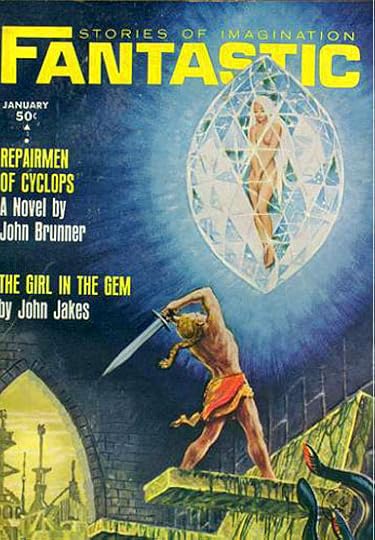
Brak meets “The Girl in the Gem” in the January 1965 issue of Fantastic. Note Brak’s signature ponytail, which gives him a resemblance to He-Man in the 1989 New Adventures of He-Man series.

Brak and friends explore “The Pillars of Chambalor” in the March 1965 issue of Fantastic.
When Cele Goldsmith Lalli left Fantastic for Modern Bride magazine, Brak’s fate like that the other sword and sorcery heroes who had appeared in its pages seemed sealed, for the new regime preferred cheap reprints to original fiction. However, when the second sword and sorcery boom was kicked into overdrive with the Lancer paperback editions of Robert E. Howard’s Conan stories, publishers scrambled to reprint any sword and sorcery they could and so the Brak stories were reprinted as a series of fix-up novels with striking Frank Frazetta covers starting in 1968. New Brak stories also continued to appear in Lin Carter’s Flashing Swords anthologies well into the time when John Jakes hit paydirt with The Kent Chronicles.
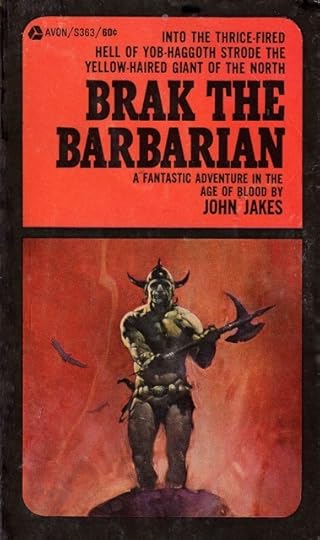
The 1968 paperback edition of Brak the Barbarian with a striking Frank Frazetta cover.
Brak the Barbarian is often called a “Clonan”, i.e. a Conan clone, but that’s unfair, because Brak is very much his own character. Yes, he is a Barbarian (and note that Conan never refers to himself as Conan the Barbarian) and an outcast from his people for daring to question their gods, but Brak is more vulnerable than Conan and frequently finds himself enslaved and forced to serve wizards against his will. Unlike Conan, who drifts through life, Brak is also on a quest to find the promised land of Khurdisan the Golden. He never finds it in the published tales, but rumour had it that there is one more Brak story in which Brak finally find the promised land, to be published only after John Jakes’ death. I really hope that rumour is true.
Even though John Jakes eventually left speculative fiction behind for the greener and more lucrative pastures of historical fiction (and who could blame him?), he nonetheless was and remained one of us, a writer and a fan of SFF and kept returning the genre throughout his life.
Rest in Peace, John Jakes.
Cora Buhlert's Blog
- Cora Buhlert's profile
- 14 followers



